inbox and environment news: Issue 527
February 20 - 26, 2022: Issue 527
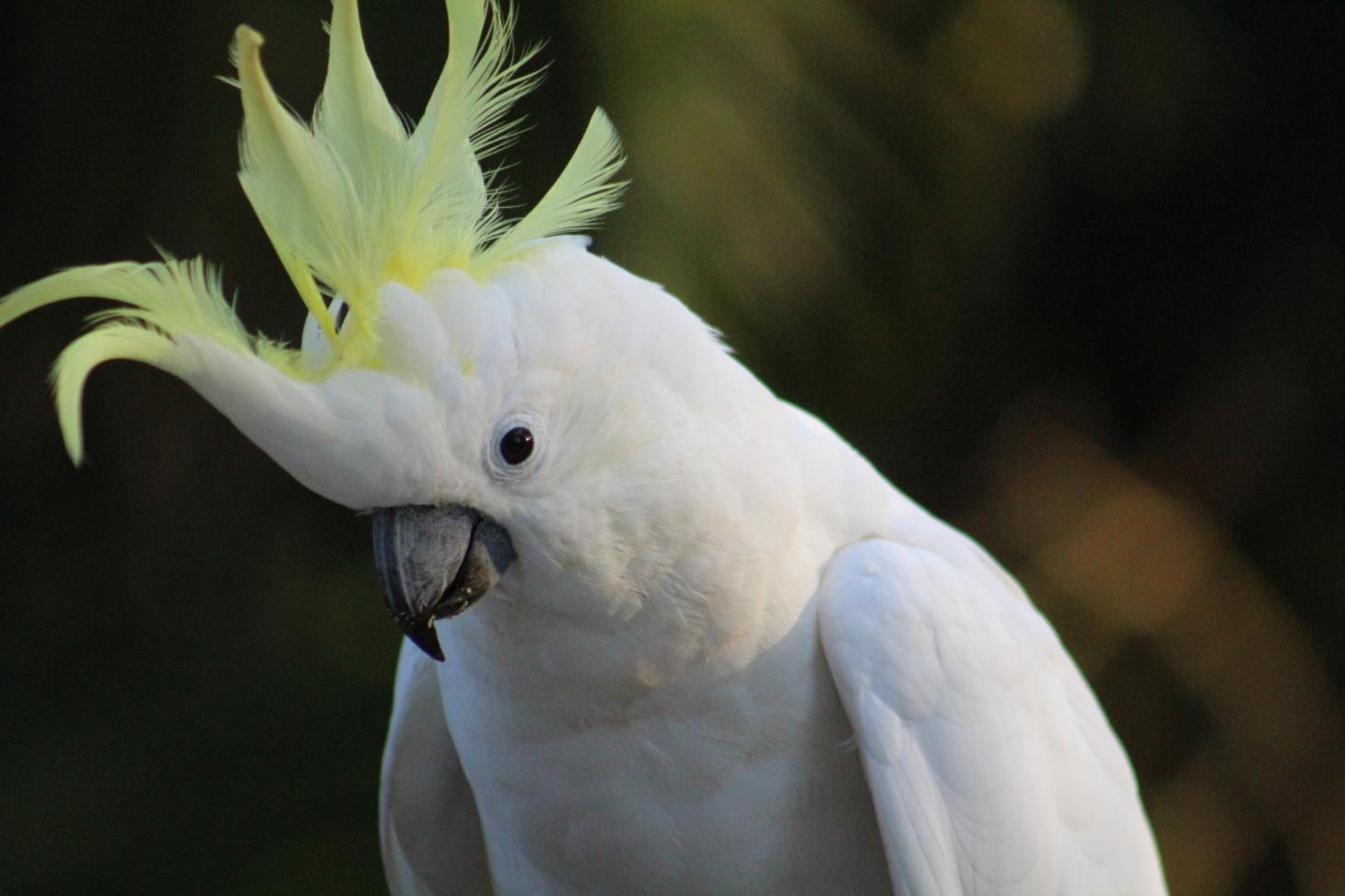
PEP-11 Update
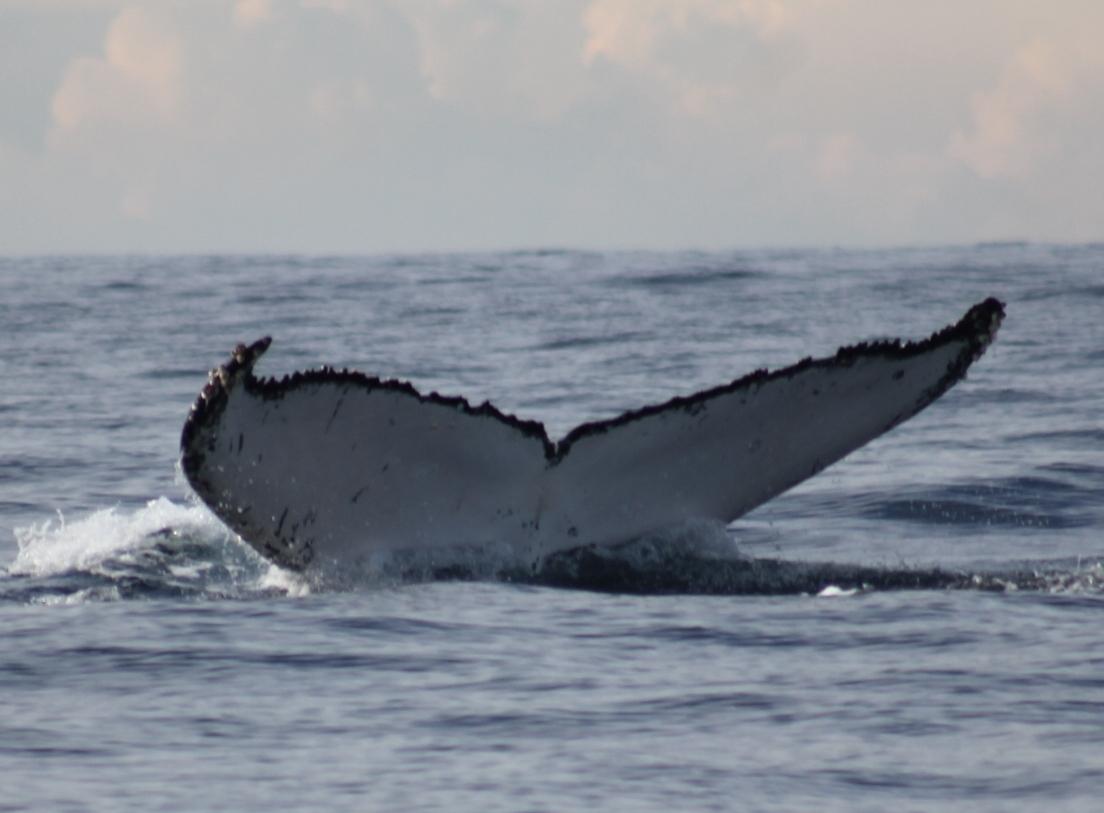
photo by A J Guesdon.
Australia’s Eucalypt Of The Year Voting Is Open For The 5th Year!
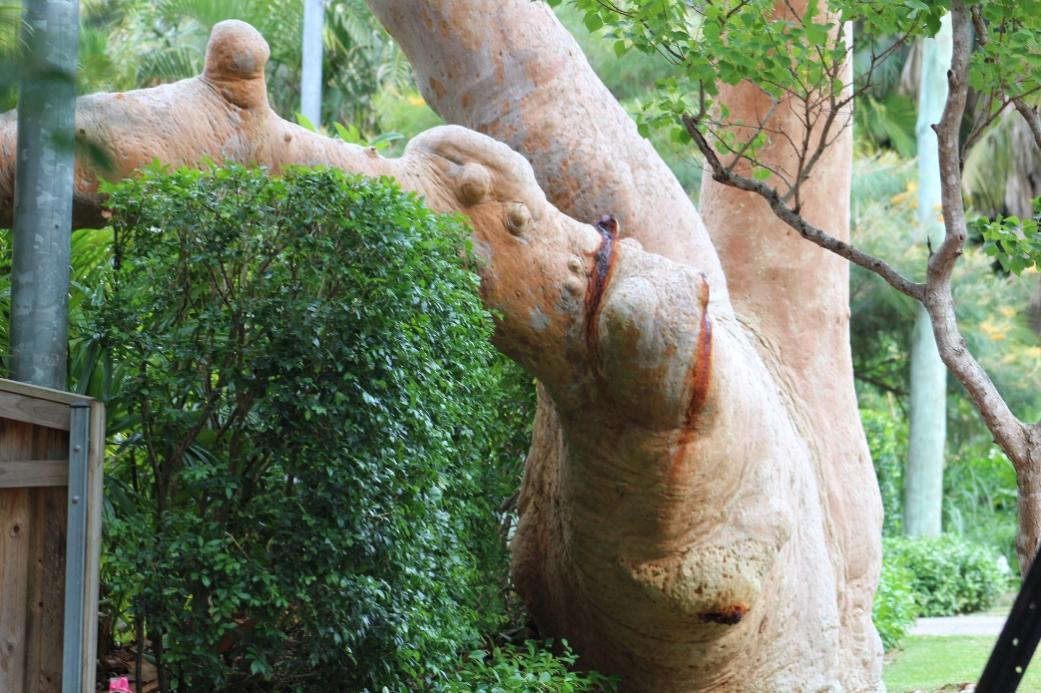
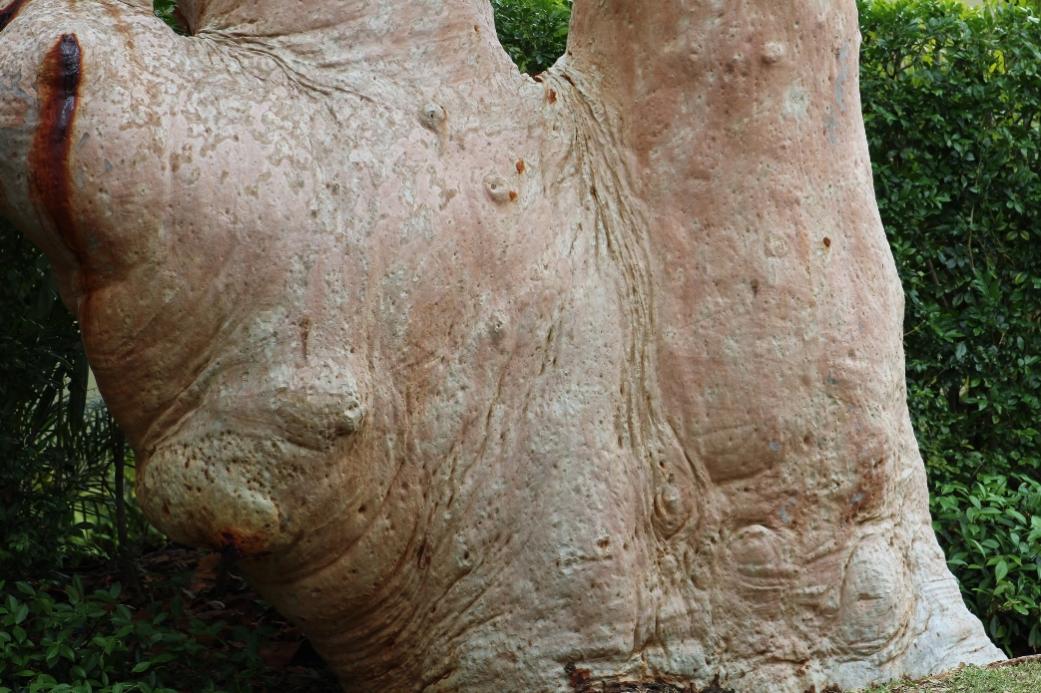

Clean Up Australia Day: Sunday March 6; 2022 - Local Sites List
- Committed to making a positive difference to the community and environment: activities should be inspiring, engaging and respectful of the local community.
- A volunteer movement: people cannot be charged to be involved in activities nor can activities be conducted for commercial or financial gain.
- Committed to the safety of volunteers: activities must be carried out in accordance with the local laws and regulations relevant to the activity.
- Uniting communities as part of a national campaign: participants must respect the presence and activities of other participants in their proximity.
- Welcoming to communities of all nations, cultures, races and faiths: participants and activities must respect political, cultural, and religious differences and beliefs
- Non-partisan: participants and activities must not imply endorsement of partisanship by Clean Up Australia.
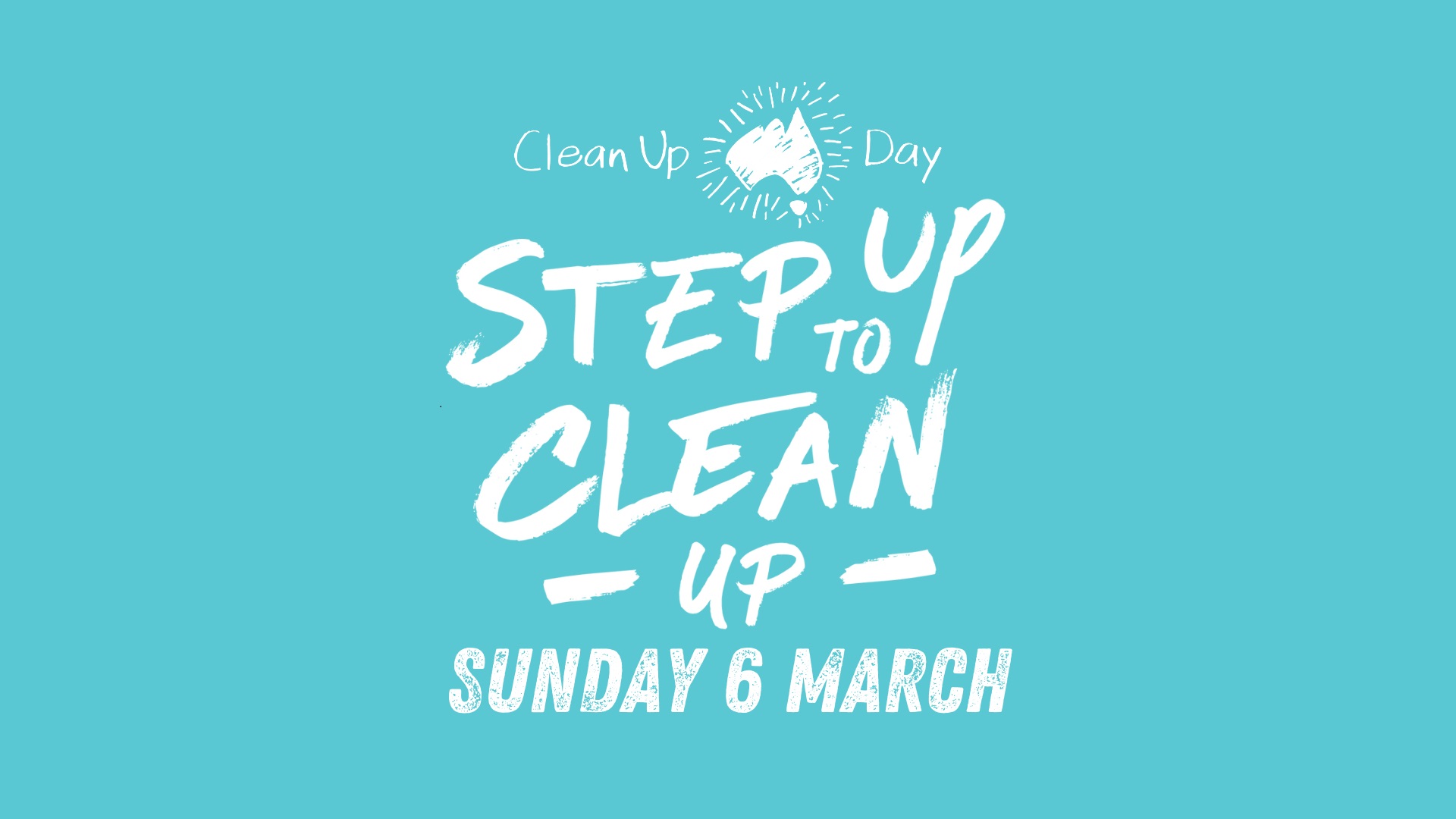
Asparagus Fern Flowering Now: Dispose Of This Weed To Stop The Spread
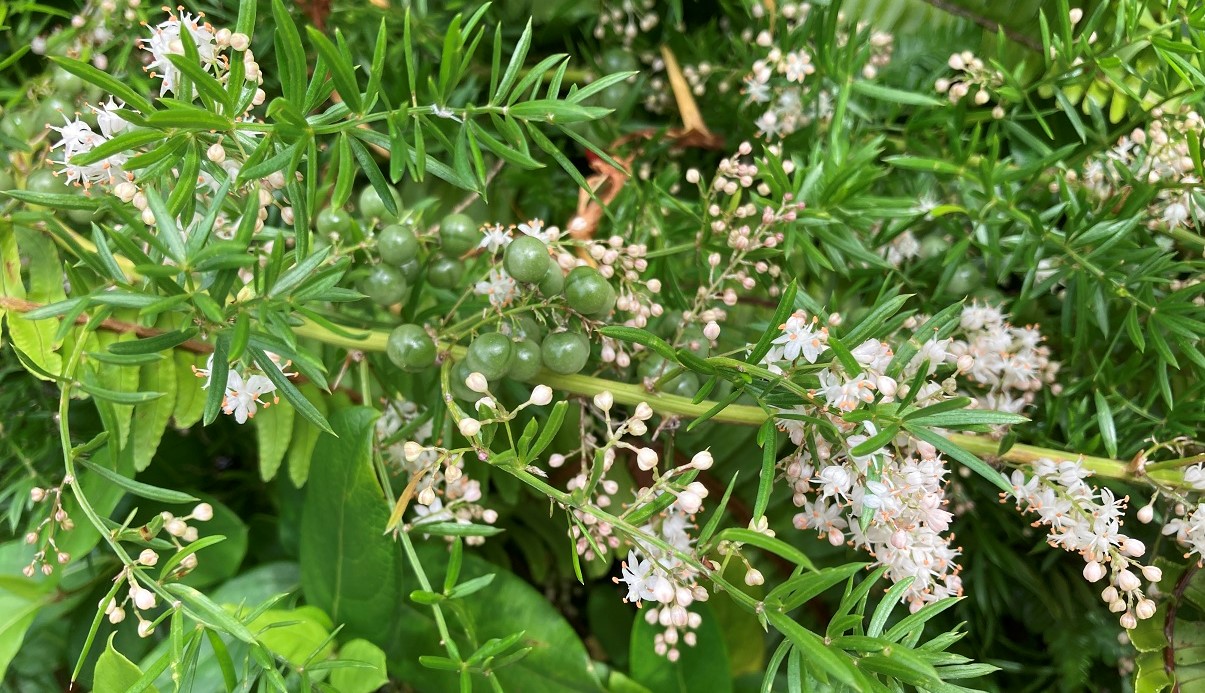
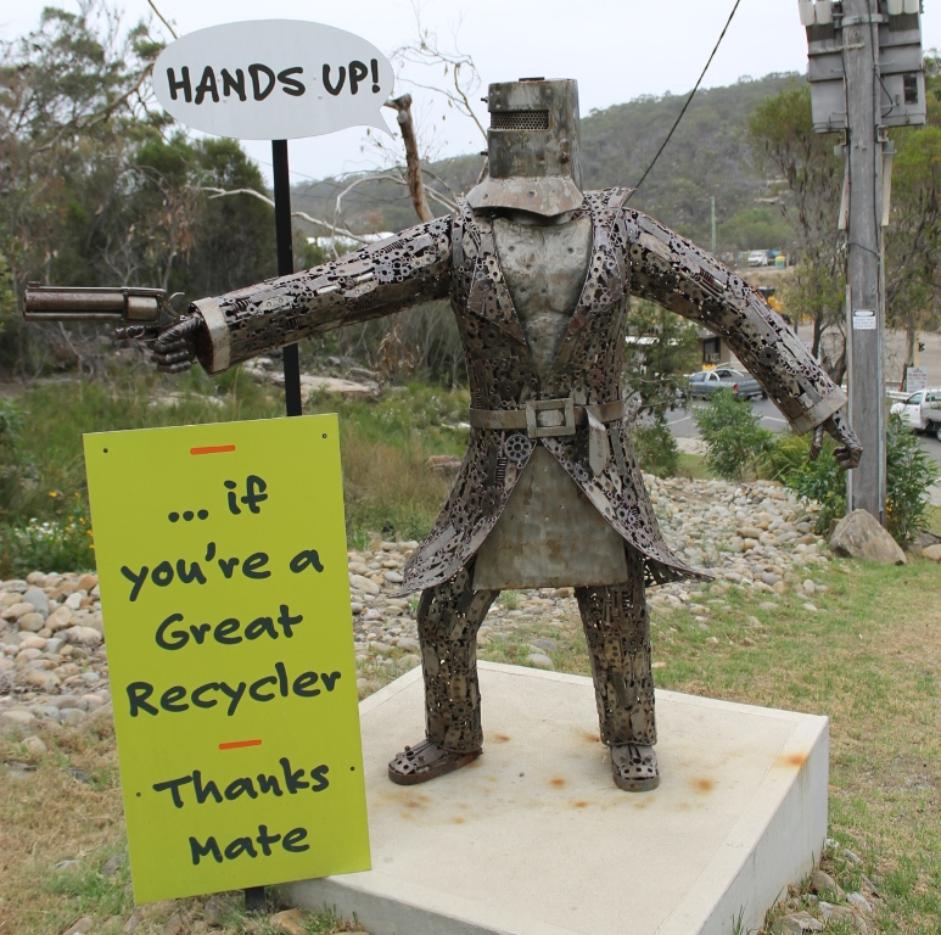
Ned Kelly sculpture at entrance to Kimbriki Resource Recovery Centre - made from discarded metals. Photo: A J Guesdon.
Friends Of Narrabeen Lagoon Catchment - Next Forum
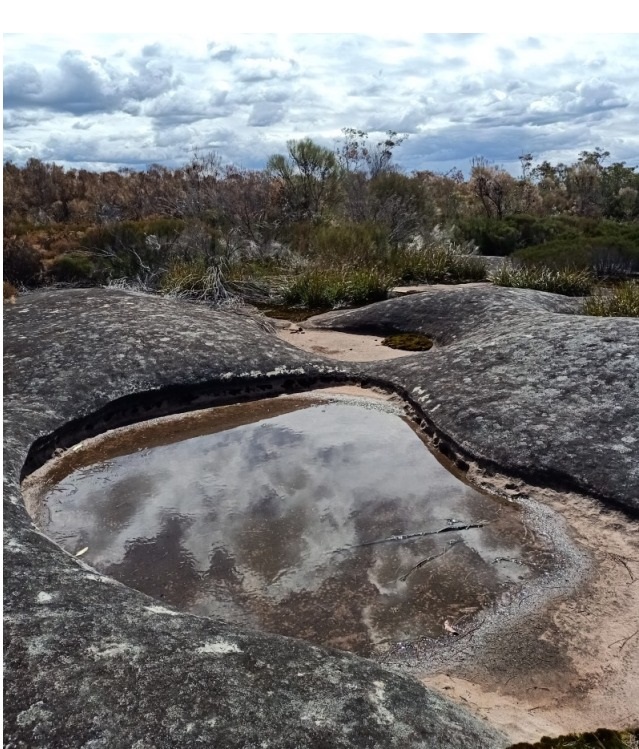
Northern Beaches Clean Up Crew Next Clean Is At: Queenscliff: Sunday 27th Of February

Powerhouse Brookvale - Australia's First Urban Renewable Energy Zone: Launch February 28
Powerhouse Brookvale Launch
Mon 28th Feb 2022, 5:00 Pm - 6:00 Pm AEDT

Electrify! Saul Griffiths On The Big Switch

The Big Switch With Saul Griffith: Electrify Everything!
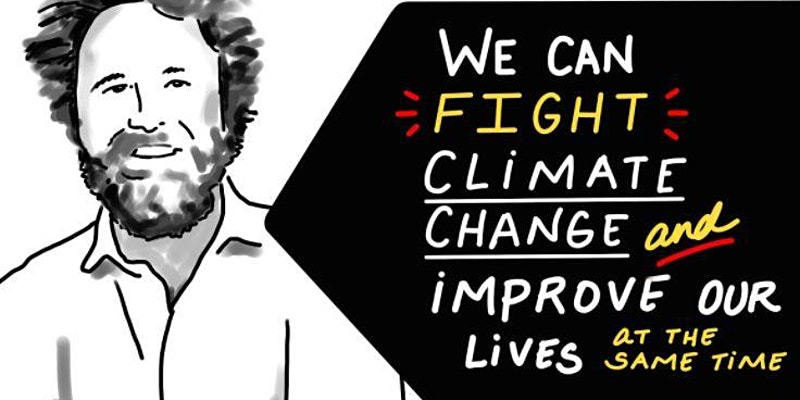 When: Wed, 23 March 2022; 6:30 PM – 8:00 PM
When: Wed, 23 March 2022; 6:30 PM – 8:00 PM Bushcare In Pittwater
Where we work Which day What time
Avalon
Angophora Reserve 3rd Sunday 8:30 - 11:30am
Avalon Dunes 1st Sunday 8:30 - 11:30am
Avalon Golf Course 2nd Wednesday 3 - 5:30pm
Careel Creek 4th Saturday 8:30 - 11:30am
Toongari Reserve 3rd Saturday 9 - 12noon (8 - 11am in summer)
Bangalley Headland 2nd Sunday 9 to 12noon
Bayview
Winnererremy Bay 4th Sunday 9 to 12noon
Bilgola
North Bilgola Beach 3rd Monday 9 - 12noon
Algona Reserve 1st Saturday 9 - 12noon
Plateau Park 1st Friday 8:30 - 11:30am
Church Point
Browns Bay Reserve 1st Tuesday 9 - 12noon
McCarrs Creek Reserve Contact Bushcare Officer To be confirmed
Clareville
Old Wharf Reserve 3rd Saturday 8 - 11am
Elanora
Kundibah Reserve 4th Sunday 8:30 - 11:30am
 Mona Vale
Mona Vale Mona Vale Beach Basin 1st Saturday 8 - 11am
Mona Vale Dunes 2nd Saturday +3rd Thursday 8:30 - 11:30am
Newport
Bungan Beach 4th Sunday 9 - 12noon
Crescent Reserve 3rd Sunday 9 - 12noon
North Newport Beach 4th Saturday 8:30 - 11:30am
Porter Reserve 2nd Saturday 8 - 11am
North Narrabeen
Irrawong Reserve 2nd Saturday 2 - 5pm
Palm Beach
North Palm Beach Dunes 3rd Saturday 9 - 12noon
Scotland Island
Catherine Park 2nd Sunday 10 - 12:30pm
Elizabeth Park 1st Saturday 9 - 12noon
Pathilda Reserve 3rd Saturday 9 - 12noon
Warriewood
Warriewood Wetlands 1st Sunday 8:30 - 11:30am
Whale Beach
Norma Park 1st Friday 9 - 12noon
Western Foreshores
Coopers Point, Elvina Bay 2nd Sunday 10 - 1pm
Rocky Point, Elvina Bay 1st Monday 9 - 12noon
Gardens And Environment Groups And Organisations In Pittwater
Sydney Wildlife Rescue: Helpers Needed

$100 Billion Of Investment Potential For Hunter-Central Coast Renewable Energy Zone
- 24 solar energy projects
- 13 onshore and seven offshore wind energy projects
- 35 large-scale batteries and
- eight pumped hydro projects.
Origin Proposes To Accelerate Exit From Coal-Fired Generation
NSW Government Response To The Closure Of The Eraring Power Station
Australia’s largest coal plant will close 7 years early – but there’s still no national plan for coal’s inevitable demise
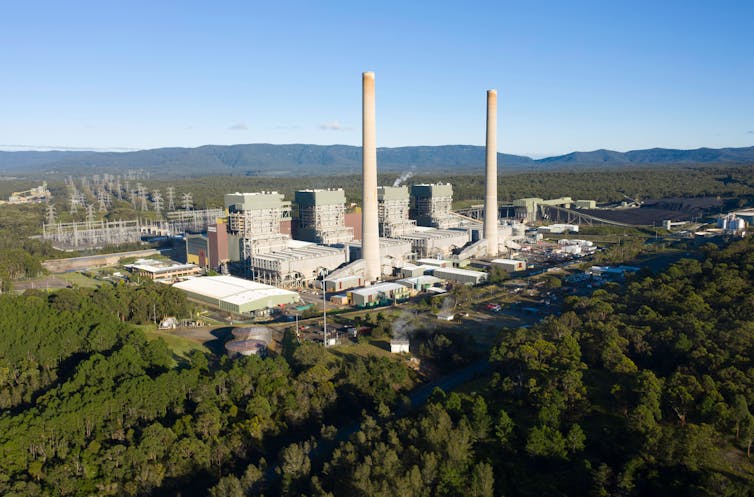
In a major step forward for Australia’s clean energy transition, the country’s biggest coal-fired power station Eraring is set to close seven years early in 2025, Origin Energy announced this morning.
Eraring has been operating for 35 years in the central coast of New South Wales. Last year, it alone was responsible for around 2% of Australia’s greenhouse gas emissions, based on calculations from electricity market and emissions data.
The fundamental reason for its early closure is the brutal impact the growth of renewable energy is having on the profitability of coal plants. Origin has announced it will be building a large, 700 megawatt battery on-site in its place to store renewable energy.
This announcement follows the acceleration of other major coal plant closures: Liddell power station is scheduled to close in 2023, Yallourn’s closure was brought forward to 2028, and only last week AGL Energy edged forwards the scheduled closure of two more coal plants.
This is a welcome step with transition planning by Origin – but also underlines the risks of Australia’s clean energy transition accelerating without a national plan for the exit of coal.
Why Is This Happening?
Old power stations are excellent sites for batteries due to their existing connections to transmission lines and lots of electricity capacity. This has also been announced for the closed Hazelwood and Wallerawang coal power stations.
Over the past 12 months, the market share of renewable energy has increased to over 30%. In particular, the rapid growth of rooftop solar and solar farms in the middle of the day has sent daytime wholesale electricity prices crashing.
To stay open, coal plants are using a variety of coping strategies. This includes cycling their output down on sunny days and ramping back up for higher prices as the sun sets and demand increases at the end of the day. However, this places stress on ageing plants and breakdowns are becoming more common.
Something has to give. Electricity market analysis last year found Eraring was the coal plant most exposed to the growth of renewable energy and likely to lose significant money by 2025 – so the writing was on the wall for Eraring.
As Origin CEO Frank Calabria, stated:
the reality is the economics of coal-fired power stations are being put under increasing, unsustainable pressure by cleaner and lower-cost generation, including solar, wind and batteries.
In announcing the closure, Origin also cited its commitment to net-zero emissions by 2050, and the recommendation of the International Energy Agency that advanced economies close coal plants by 2030.
What Will Happen To The Market And Workforce?
When the Hazelwood coal power station closed in 2017 with just a few months notice, power prices spiked for several years afterwards and many workers were unable to find alternative work.
Origin, however, has given three-years notice in accordance with electricity market rules brought in after the shockwaves from Hazelwood’s closure, and announced it will develop a transition plan for its workforce. This includes training, redeployment and prioritising site employees for long-term operational roles.
Origin presented figures showing the energy and capacity gap will be filled by a combination of new storage, Snowy 2.0, a new transmission line to move power between South Australia and NSW, and new renewable energy infrastructure scheduled for NSW.
Consequently, the impact on prices is likely to be modest compared to the Hazelwood closure.
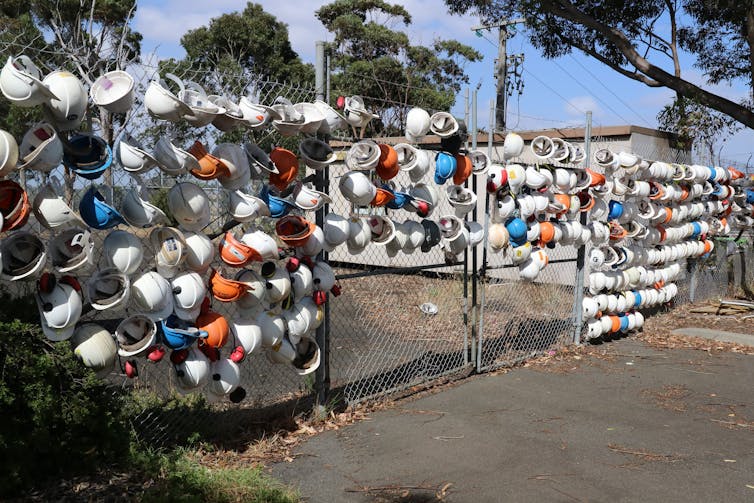
Eraring’s closure may provide other coal plants some breathing space. Coal plant owners have effectively been playing a game of chicken, holding on and hoping another plant shuts to tighten supply and increase prices.
But as Origin’s figures illustrate, there’s a lot more renewable energy projects in the pipeline, and its figures don’t include the tremendous growth of rooftop solar, which last year saw over 3,000 megawatts installed.
So this is unlikely to be the last of the coal plant closures in our near future. Indeed, in the draft 2022 Integrated System Plan (a “roadmap” for the electricity system), the Australian Energy Market Operator projects as much as 60% of coal plant capacity could be gone by 2030.
We Still Don’t Have An Exit Plan For Coal
Even though coal plants are shutting up shop faster, Australia still doesn’t have an exit plan for coal. That’s unlikely to change, given neither major party is going to want to “own” the closures in an election year.
As a result, this pattern seems likely to continue: renewable energy will continue to grow as the cheapest form of electricity generation, governments will put in place policies to accelerate its growth, and it will be left to the market and asset owners to make decisions on closures without a policy framework. This is extremely risky.
Origin has done the right thing by giving three-years notice, committing to a transition plan for its workforce and investing in battery storage.
But energy market players don’t consider the penalties for not complying with notice requirements an effective deterrent, compared to the financial incentive to hang on and hope for a price uplift when other plants close.
This means we’re left relying on the owner’s goodwill, enlightened self-interest and fear of reputational damage to act responsibly.
Maybe Australia will muddle through like this. But without a plan, we’re at risk of a rush of closures in future years with disastrous impacts on electricity prices, regional economies and livelihoods in coal communities.
We Need Policy Commitments
A variety of models for an orderly exit from coal have been proposed and national agreements have been negotiated to phase out coal in other nations such as Germany and Spain.
While the Australian Energy Market Operator has noted there are technical challenges in the clean energy transition, it considers they can be addressed. There’s no lack of alternative generation and storage to fill the energy gap from retiring coal plants.
Just this week, the NSW government received expressions of interest from renewable energy and storage projects worth over A$100 billion. The government observed that this was equivalent to the electricity output of ten coal-fired power stations in the Hunter Valley Renewable Energy Zone.
Hopefully on the other side of the election there’ll be a political and policy commitment to an orderly exit from coal - a plan that can manage impacts on our electricity system and support coal power station workers through the inevitable transition.![]()
Chris Briggs, Research Director, Institute for Sustainable Futures, University of Technology Sydney
This article is republished from The Conversation under a Creative Commons license. Read the original article.
How our album of birdsong recordings rocketed to #2 on the ARIA charts
Stephen Garnett, Charles Darwin University and Anthony Albrecht, Charles Darwin UniversityAustralia is losing its birds at an alarming rate – one in six species are now threatened with extinction, predominantly due to climate change, land clearing and worsening bushfires.
Last year, when we met in a Darwin cafe to discuss Anthony’s PhD on the impact of environmental art on conservation, we wondered if his project could contribute to saving threatened birds.
Could we, perhaps, harness the beauty of birdsong to help Australians care about what they were losing?
Throughout history, humans have been inspired by the complex melodies and rhythms of birdsong. It’s a natural, daily celebration of our biodiversity, and has shaped the evolution of human speech and song for millennia.
Our idea was to let the threatened birds speak directly to those who might help them.
Teaming up with renowned bird recordist David Stewart, we created a CD for the music charts consisting entirely of bird calls, titled Songs of Disappearance. For the title track, the Bowerbird Collective’s Simone Slattery arranged a fantasy dawn chorus of 53 threatened species.
As of February 18, the CD – now with a video by Senior Gooniyandi artist Mervyn Street and Bernadette Trench-Thiedeman – was sitting at No.2 on the charts.
Among The Stars
Launched on December 3, 2021, the album debuted at No.5 on the ARIA charts, in part because the conservation organisation BirdLife Australia alerted its supporter base to a wonderful Christmas present that would also help bird conservation.
Some calls on the CD are astonishing for their rarity. Night parrots, critically endangered with a bell-like call, were lost for a century before they were rediscovered in 2013. Regent honeyeaters are now so scarce that young birds lack models from which to learn their soft, warbling calls.
Others are poignant cries of a disappearing landscape - the creaking calls of gang-gangs, buzzing bowerbirds and the mournful cry of the far eastern curlew.
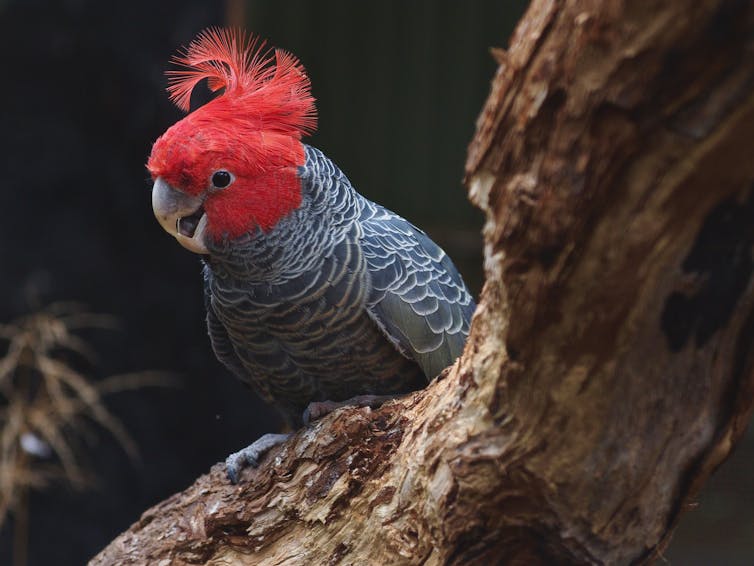
Some purchasers of the CD have written to say they have the 53 calls on loop.
Two weeks after its release, the CD reached number 3, ahead of such artists as Taylor Swift, Mariah Carey and Michael Bublé.
“I’m very happy to have birds flying above me!” Paul Kelly told us when Songs of Disappearance displaced his Christmas Train album.
Suddenly, retail giants wanted our album in their stores. Media requests flowed in from around the world. Our CDs are being manufactured and distributed for release in the United States.
Now it’s at number 2 on the ARIA charts – a pretty good result for threatened species from a project with a zero marketing budget. It may also be the first time, anywhere in the world, that a university research project has hit the music charts.
Will The Calls Be Answered?
In December last year, more than 300 of Australia’s leading ornithologists released the Action Plan for Australian Birds 2020. It found 216 Australian birds are now threatened with extinction, mainly due to climate change.
The devastating findings of the action plan are what spawned our idea. The resulting combination of research, conservation, and creativity told a story that has resonated globally, something the action plan alone would never have achieved.
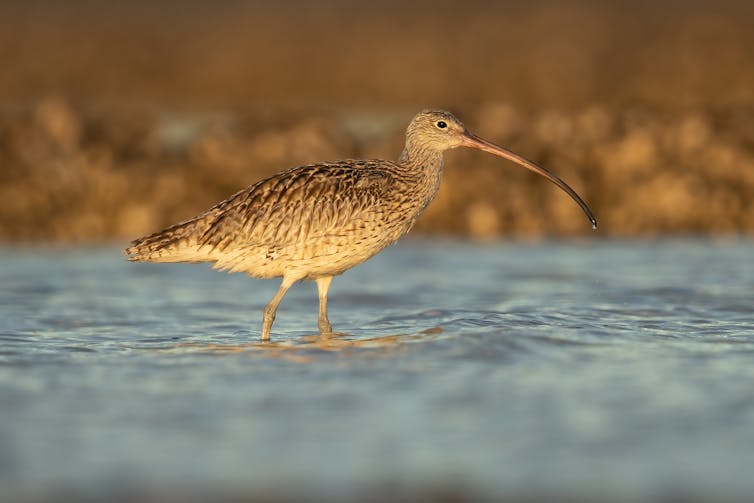
But will it make a difference?
Certainly the profits, which go to BirdLife Australia, will be put to good use. However, the 200 Australian bird taxa identified in the action plan need far more assistance to survive than one CD can provide.
The question is, can art help change population trajectories? Or, as cultural policy expert Christiaan De Beukelaer writes, will these haunting bird calls just “naturalise the awful future it wishes to avert”, like other climate apocalyptic art?
The answer is that we do not know - hence our ongoing research. However, we do know that, 60 years ago this year, the fear of losing birdsong implied by conservationist Rachel Carson’s book Silent Spring helped launch the environmental movement.
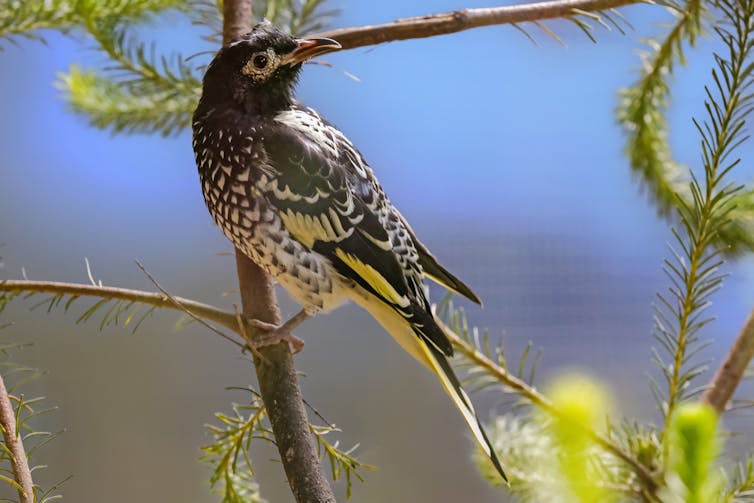
Where Will The Songs Lead Us?
Songs of Disappearance now presents a fascinating opportunity to understand whether it can catalyse some of the same impetus for change.
Those who purchased the album have been invited to complete a survey to help us understand whether this project and others like it can have a lasting effect on conservation outcomes.
We wish to know, for example, whether the CD has affected people emotionally. Conservation, like art, is a belief system driven by deep emotions. As 2020 research suggests, empathy for wildlife is strongly linked to a sense of moral justification for preventing extinctions.
So, has the CD changed behaviour? We know bird song, like music, boosts mental well-being. But can it turn intention into action? And if so, what sort of action? We also aim to learn lessons from this experience that might be transferred to other projects involving the arts and conservation.
The disappearance of Australian bird song is by no means inevitable. How wonderful if the songs of the birds themselves can help secure their future.![]()
Stephen Garnett, Professor of Conservation and Sustainable Livelihoods, Charles Darwin University and Anthony Albrecht, PhD Candidate, Charles Darwin University | Co-founder, The Bowerbird Collective, Charles Darwin University
This article is republished from The Conversation under a Creative Commons license. Read the original article.
Western Sydney will swelter through 46 days per year over 35°C by 2090, unless emissions drop significantly
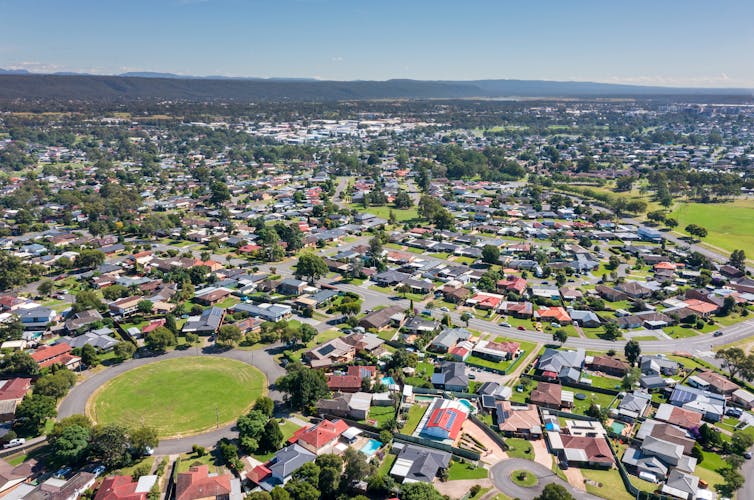
If emissions continue to accelerate, Western Sydney can expect to endure up to 46 days per year over 35℃ by 2090, a new analysis from the Australia Institute finds. This is a fivefold increase from the historical average of just under nine days of extreme heat per year.
Western Sydney, home to around 2.5 million people, is highly vulnerable to extreme heat and is 8-10℃ hotter than east Sydney during heatwaves. The region is too far inland to benefit from coastal breezes, and lacks the altitude of the neighbouring Blue Mountains.
The furthest inland suburbs, such as Penrith, are hottest. Indeed, in early January, 2020, Penrith was the hottest place on Earth, reaching a scorching high of 48.9℃.
However, such a dramatic rise in extreme heat days is not inevitable. If global warming is limited to 1.5℃ this century, in line with the Paris Agreement, Western Sydney will have fewer than 17 days of 35℃ per year by 2090. Emissions reduction and smart urban design are urgent measures to protect Western Sydney-siders from heat stress.
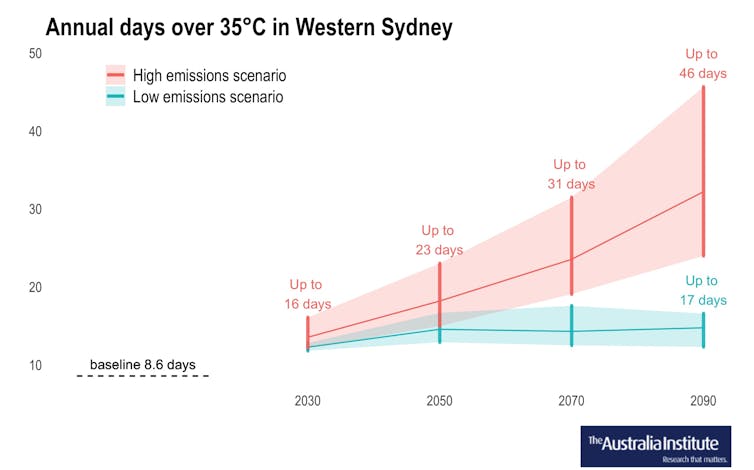
Heatwaves Are Deadly
In Australia, heat accounts for more deaths than all other natural disasters combined. If the power goes out, it’s much harder to mitigate the stress.
In January 2009, during the devastating heatwave that preceded the Black Saturday fires, Melbourne experienced a power outage on a 44℃ day, leaving some 500,000 people in the heat without electricity. The heatwave alone killed 374 people, and cost Melbourne an estimated A$800 million.
Heat also acutely affects worker productivity. The New South Wales treasury estimates that by 2061, the state could lose up to 2.7 million working days every year from reduced worker productivity in agriculture, construction, manufacturing and mining, due to heat.
However, under a low-emissions pathway, NSW estimates the loss in worker productivity could be limited to about 700,000 days. While this is still significant, it’s a quarter of cases compared to a high-emissions future.
To find out how climate change would affect Western Sydney, we analysed climate projections from the Bureau of Meteorology and CSIRO. We calculated temperature projections using a low-emissions scenario (where global warming is stopped at 1.5℃) and a high-emissions scenario (where global emissions continue unabated).
Examining 12 federal electorates that make up Western Sydney, we found the electorate of Lindsay, which includes the city of Penrith, will be most impacted. It can expect up to 58 days of 35℃ by 2090 under a high emissions scenario.
Who Is Impacted?
Western Sydney is uniquely prone to the “urban heat island” effect. The dense concrete and lack of green spaces absorbs and amplifies heat, raising temperatures to dangerous levels.
Residents without access to affordable air conditioning, with preexisting medical conditions or who work outdoors are most at risk of heat stress.
To understand the human impact of extreme heat, we partnered with extreme heat advocacy nonprofit Sweltering Cities. They conducted a targeted survey of Western Sydney in 2020, collecting insights from 682 respondents.
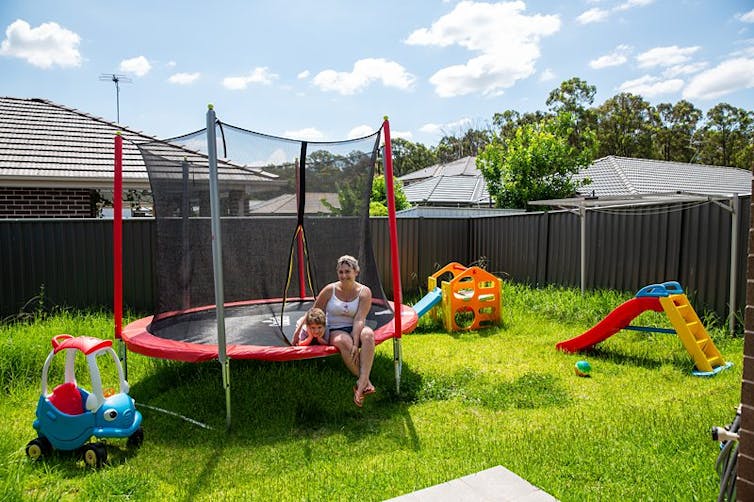
Gemma MacMillan is a single mum of a three-year-old boy, living in affordable housing in Ropes Cross. “In summer I have to keep my son Oliver inside as much as possible on hot days,” she says. “There’s no shade at all in my backyard.”
Gemma has lived in a house without air conditioning or ceiling fans. “In the past we’ve gone to stay with my ex-partner’s mum who has an air con, but now we’ve broken up and I worry about my son when it’s really hot.”
Even though retired chemist Rafael Perez has air conditioning, he says: “you’ve got to think of the cost. I’m not in a position to have it on all the time so I turn it off as soon as I can.”
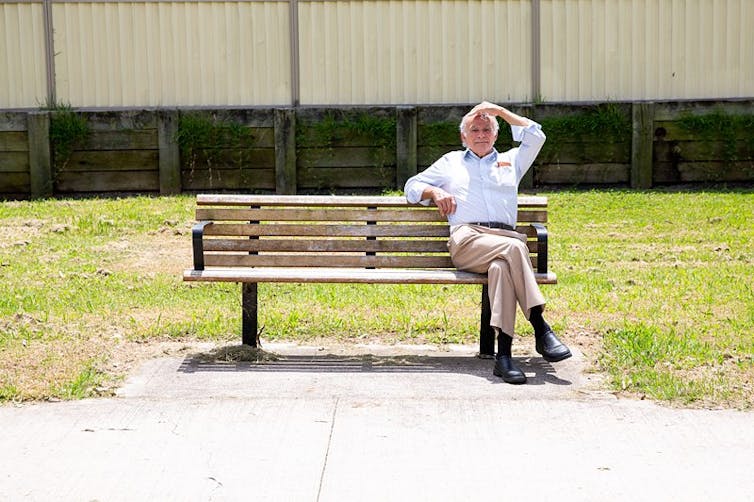
In fact, despite Western Sydney having, on average, lower income levels, residents in areas such as Penrith are paying on average up to $100 per month more in electricity bills than those living closer to the coast.
Reflecting on his 22 years in the neighbourhood, Rafael says, “there used to be a lot more trees when I moved here, now there is a lot more concrete.”
What Needs To Change?
Reducing emissions is the difference between 1.5 months and 17 days of extreme heat per year in Western Sydney.
Thankfully, there is appetite for change. Earlier this month, for example, prominent cricketer Pat Cummins launched Cricketers for Climate in Penrith, a movement for Australian cricket clubs to achieve net-zero emissions over the next decade. The initiative highlights how the climate crisis threatens our ability to play sports, and positions athletes as advocates for climate action.
Additionally, the upcoming federal election could provide the policy window to increase climate ambition, as Western Sydney has a number of highly contested swing seats. According to the Sweltering Cities survey, 92.5% of Western Sydney residents say they want politicians and political parties to have policies on heat.
What do these policies look like? At the local level, we need to design our cities and homes to protect vulnerable members of the community. The NSW government recently announced a move to ban dark roofs. Lighter coloured roofs reflect heat, and can reduce indoor temperatures by 10℃ during heatwaves.
Increasing green spaces, ensuring bus stops and parks are adequately shaded, and providing affordable access to air conditioning are also crucial steps to making Western Sydney safe.
Most importantly, preventing extreme heat requires a significant emissions reduction. Australia’s national target of a 26-28% emissions reduction from 2005 is consistent with warming of 4℃, if all other countries were to follow a similar level of ambition. At the state level, instead of planning new coal mines, NSW should accelerate its transition to renewable energy.![]()
Hannah Melville-Rea, Research Fellow, New York University
This article is republished from The Conversation under a Creative Commons license. Read the original article.
‘Highly exaggerated’: experts debunk Morrison government claim of 53,000 fewer jobs from coal and gas ban
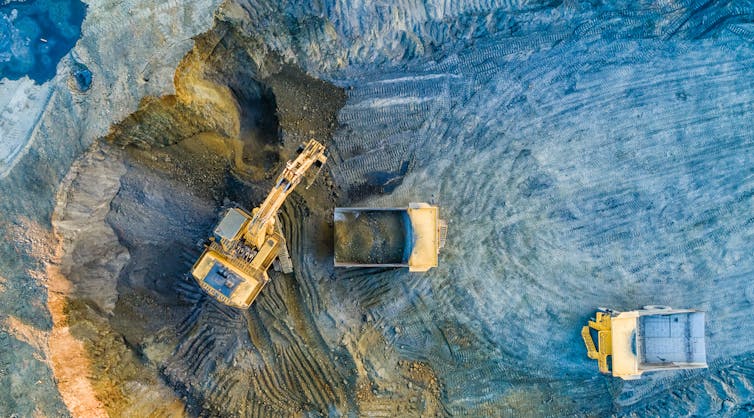
In an analysis recently released to News Limited newspapers, the Morrison government claims banning new coal and gas projects in Queensland would risk 53,000 jobs and A$85 billion in investment.
But we checked the job claims and found them highly exaggerated.
The government analysis, released by federal Resources Minister Keith Pitt, came in response to a call by the Greens for a six-month moratorium on new coal, oil and gas projects.
We analysed the most recent government data. We found even in an extreme scenario where all new coal and gas projects are banned, reductions in future Queensland jobs would be at most one-tenth of what the minister claims.
A Ban Won’t Affect Every Project
The most recent government dataset lists 44 coal projects and nine gas projects in Queensland. Two of the gas projects have already started production, so we discounted these from our analysis.
The rest of the dataset comprises the following projects:
six “committed” projects: those with environmental and planning approvals and a final investment decision
29 “feasible” projects: undergoing detailed analysis on their commercial viability, and awaiting environmental and planning approvals
16 “announced” projects with no detailed work behind them yet.
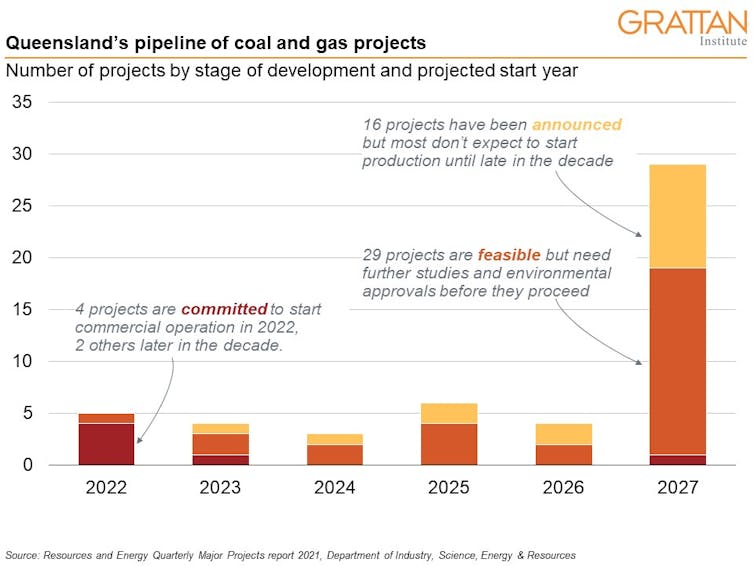
Committed projects wouldn’t be affected by a ban, because authorities have already approved them. That means associated jobs won’t be affected either. Some 2,700 construction jobs and 2,086 operational jobs are associated with these projects.
The ban would only affect projects not yet approved – the 45 projects classified “feasible” or “announced”. From now on we’ll refer to these projects as “uncommitted”.
If all 45 of these projects went ahead, it would create 26,853 additional construction jobs in Queensland and 19,131 operational jobs – or about 46,000 jobs in total.
Not Every Project Will Be Developed
Most of these uncommitted projects will only ever exist on paper.
Official data reveals 29 of the 45 uncommitted projects have been on the books for five years or more without moving to “committed” status.
Of the projects that were uncommitted in 2017, only five were listed in 2021 as committed or operating. This progress rate is much worse for coal than gas. Half the gas projects on the books in 2017 are now committed or operating, compared to just 6% of coal projects.
If this trend is repeated over the next five years, just one in two Queensland gas projects and one in 16 Queensland coal projects would proceed. This would mean Queensland could expect 4,406 new coal and gas jobs, comprising:
- 3,013 additional jobs in construction (1,488 in coal and 1,525 in gas)
- 1,393 additional operational jobs (1,168 jobs in coal and 225 in gas).
It’s these 4,406 jobs that wouldn’t be created if there was a ban on new coal and gas projects – a far cry from the 53,000 estimated by the Morrison government.
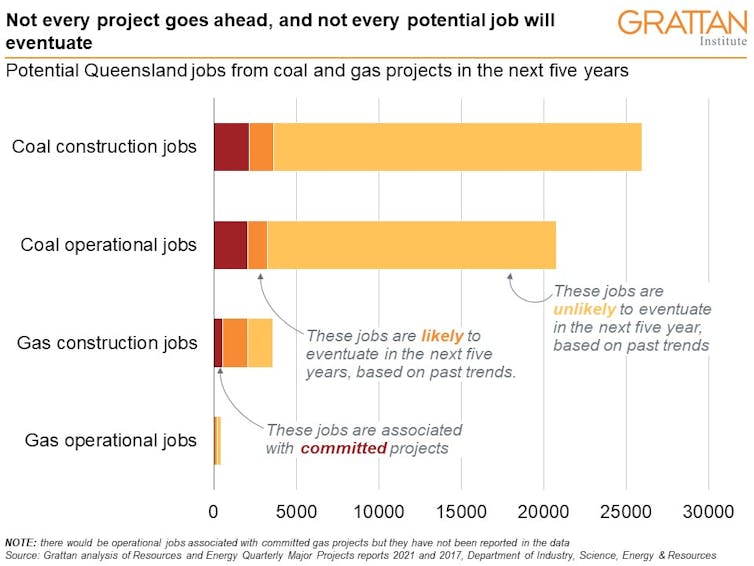
Some 18 projects in the dataset don’t report job numbers, and our analysis doesn’t assume any jobs from these projects. Three of these are committed or complete (so there are more jobs locked in than our estimate of 4,786 suggests). Fifteen are uncommitted, meaning our estimate of the jobs impacted by a ban might be slightly low.
We also examined historic data for the small number of committed projects where job number estimates were provided. None created more jobs than their initial estimate, and some provided fewer.
In one case, Adani’s Carmichael mine, there were 975 fewer construction jobs and 2,270 fewer operational jobs in the 2021 data than estimated in 2017.
So, all this suggests even the more realistic job numbers we calculated aren’t guaranteed to come to fruition.

Bigger Worries For Regional Queensland
Overall, at least 4,786 jobs are locked in for Queensland from committed projects. A further 4,406 could be expected over the next five years if other projects go ahead.
Those 4,406 jobs, most in regional areas, are a lot to give up. In a small regional town, even an extra ten jobs can mean the local primary school retains all its teachers, the bank stays open and the pub remains viable. We shouldn’t dismiss the importance of this.
Queensland relies on coal and gas jobs more than some other states. But scaremongering and inflated claims about foregone jobs don’t help the debate – or help people who live in regional areas.
If the world is serious about achieving its collective goal of net-zero emissions, we can expect Australia’s coal exports to fall by 60% between 2020 and 2030.
It is this falling demand, not a moratorium or a ban, which will have the biggest effect on jobs and regional communities. And it is here that whichever party wins the 2022 election must focus its attention.![]()
Alison Reeve, Deputy Program Director, Energy and Climate Change, Grattan Institute and Tony Wood, Program Director, Energy, Grattan Institute
This article is republished from The Conversation under a Creative Commons license. Read the original article.
World-first research confirms Australia’s forests became catastrophic fire risk after British invasion
Michela Mariani, University of Nottingham; Michael-Shawn Fletcher, The University of Melbourne, and Simon Connor, Australian National UniversityAustralia’s forests now carry far more flammable fuel than before British invasion, our research shows, revealing the catastrophic risk created by non-Indigenous bushfire management approaches.
Contemporary approaches to forest management in Australia are based on suppression – extinguishing bushfires once they’ve started, or seeking to prevent them through hazard-reduction burning.
This differs from the approach of Indigenous Australians who’ve developed sophisticated relationships with fire over tens of thousands of years. They minimise bushfire risk through frequent low-intensity burning – in contrast to the current scenario of random, high-intensity fires.
Our research, released today, provides what we believe is the first quantitative evidence that forests and woodlands across southeast Australia contained fewer shrubs and more grass before colonisation. This suggests Indigenous fire management holds the key to a safer, more sustainable future on our flammable continent.
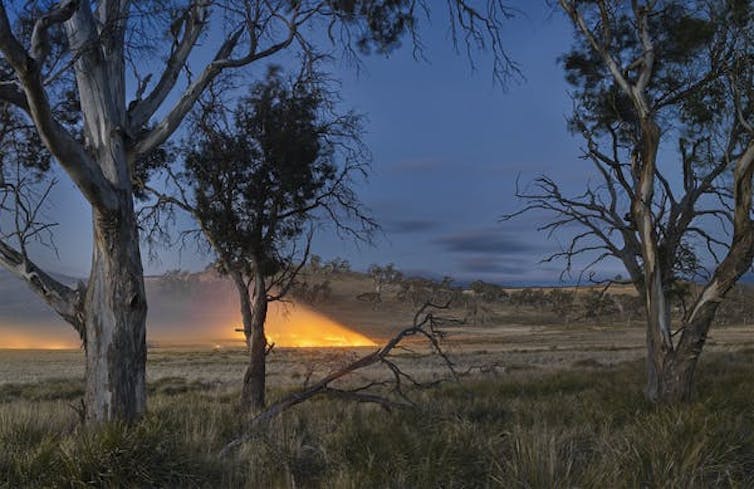
Not Just A Climate Story
Globally, climate change is causing catastrophic fire weather more often. In Australia, long-term drought and high temperatures were blamed for the Black Summer bushfires in the summer of 2019-20. This event burned 18 million hectares, an area almost twice the size of England.
The unusually high fire extent in forests prompted several important questions. Could these massive fires be explained by climate change alone? Or was the way we manage forests also affecting fire behaviour?
Recent catastrophic fires in Australia and North America prompted renewed scrutiny of how the disruption and exclusion of First Nations’ burning practices has affected forest fuel loads.
Fuel load refers to the amount of flammable organic matter in vegetation such as leaves, twigs, branches and trunks. Large fuel loads in the shrubby layers of vegetation enable flames to more easily reach tree canopies, causing intense and dangerous “crown” fires.
Long before British invasion of southeast Australia in 1788, Indigenous people managed Australia’s flammable vegetation with “cultural burning” practices. These involved frequent, low-intensity fires which led to a fine-grained vegetation mosaic comprising grassy areas and scattered trees.
Landscapes managed in this way were less prone to destructive fires.
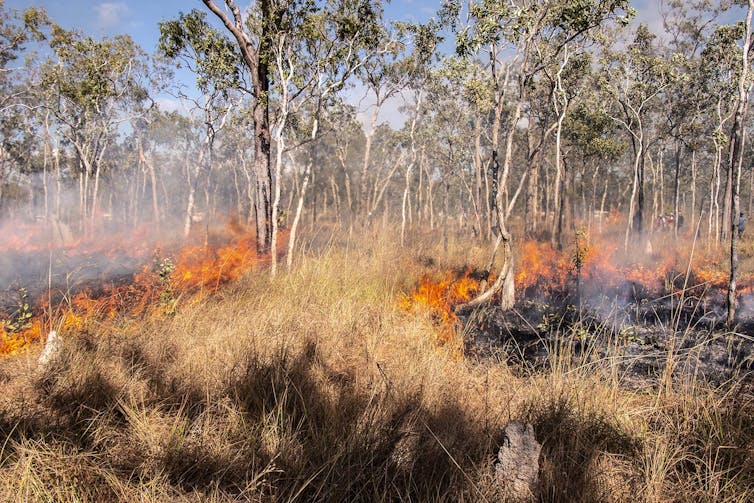
But under colonial rule, Aboriginal people were dispossessed of their lands and often prevented from carrying out many important practices.
The colonisers suppressed Indigenous cultural burning – sometimes to protect fences – causing the land to become overgrown with shrubs.
Colonial vegetation management involved clear-cutting and intense intentional burning to create land on the plains for agriculture. Forests in rugged and less desirable terrain were left unmanaged or exploited through logging.
A fire-fighting mentality came to dominate fire management in Australia, in which fires are seen as a threat to be prevented, or stopped once they start. This thinking underlies mainstream fire and land management to this day.
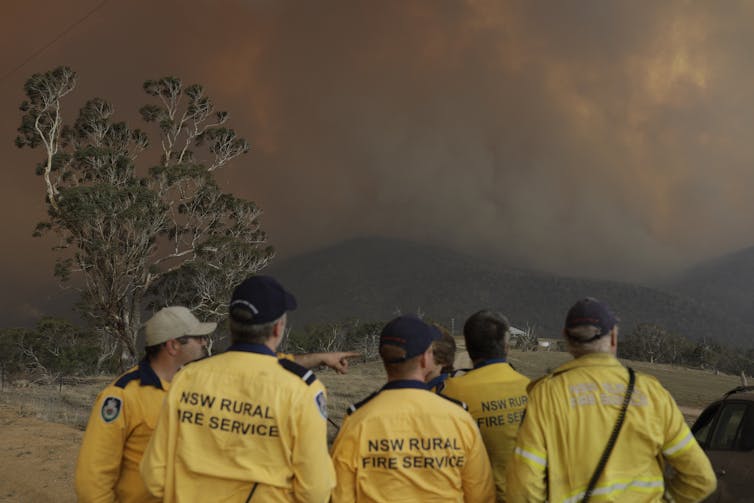
Uncovering Past Landscapes
Our research set out to examine vegetation change at 52 sites across much of Australia’s southeast before and after colonisation in 1788. A large proportion of these are in forested areas of Victoria and New South Wales.
Scientists can develop a picture of past vegetation by extracting tiny fossilised grains of pollen from ancient sediment in wetlands and lake beds. Different plants produce pollen grains with different shapes, so by analysing them we can reconstruct past vegetation landscapes.
We also calibrated the amount of pollen to vegetation cover, to determine the past proportions of trees, shrubs, and grasses and herbs.
We did this using new modelling techniques that allow the conversion of pollen grain counts to plant cover across the landscape. These models have been widely applied in Europe, but our work represents a first in Australia.
We could then quantify vegetation changes before and after British invasion. We found forests in the southeast are now much denser, and more flammable, than before 1788.
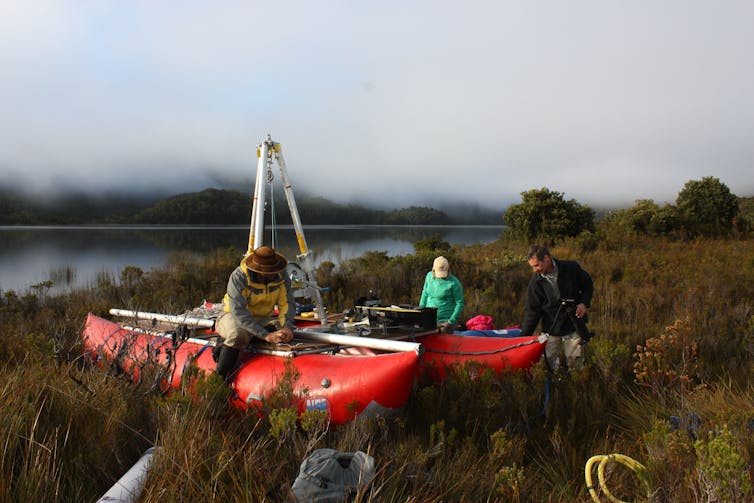
We found grass and herb vegetation dominated the pre-colonial period, accounting for about half the vegetation across all sites. Trees and shrubs covered about 15% and 34% of the landscape, respectively.
After British invasion, shrubbiness in forests and woodlands in southeast Australia increased by up to 48% (with an average increase of 12%). Shrubs replaced grassy areas, while tree cover has remained stable overall.
Considering the vast area covered by our analysis, the shrub increase represents a massive accumulation of fuel loads.
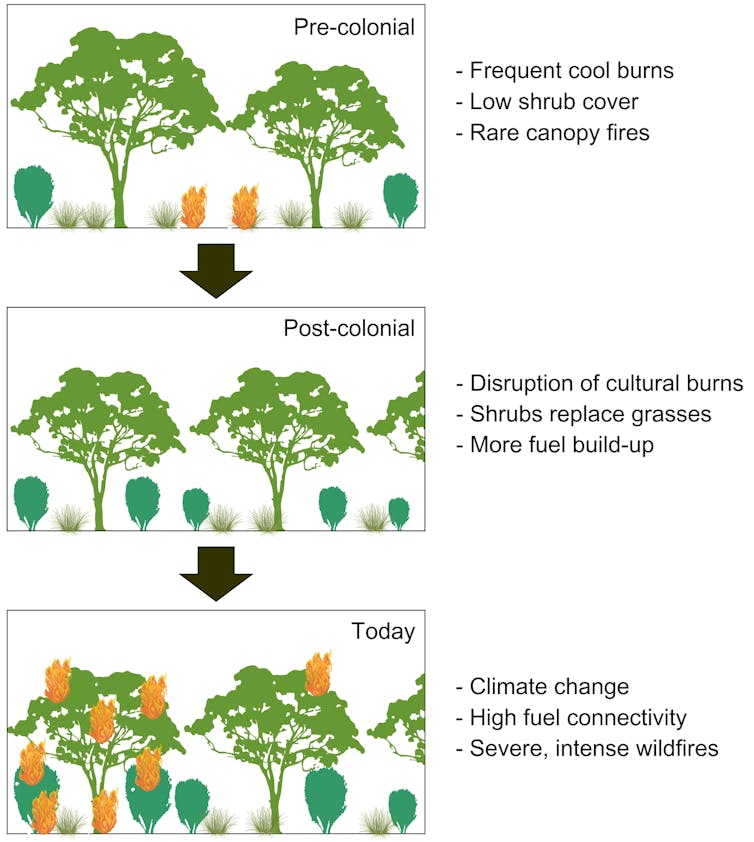
More Than 200 Years Of Neglect
In 1770, natural history artist Sydney Parkinson described the landscape along Australia’s east coast as “free from underwood […] like a gentleman’s park”.
In 2011, historian Bill Gammage published a controversial book titled The Biggest Estate on Earth. It contained several paintings of early colonial Australia in which the landscapes resembled a savanna, with large gaps between trees and a grassy understorey.
Nowadays, many such areas are dense forest. Our research is the first region-wide analysis that gives scientific credence to these historical accounts of a landscape very different to what we see today.
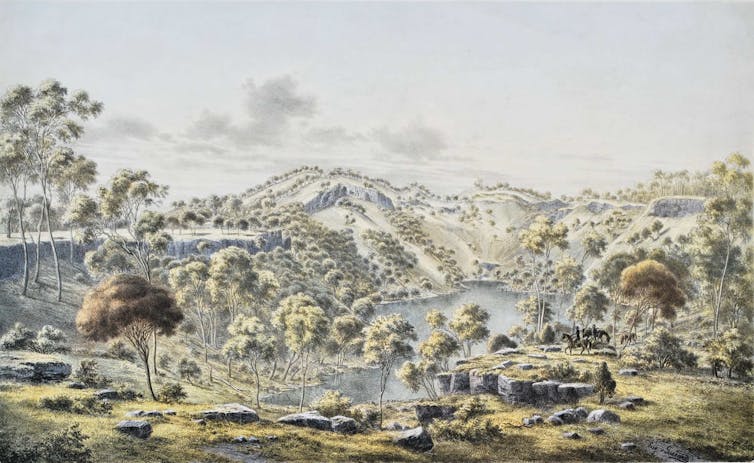
The disposession of Indigenous Australians by British invaders has had a deep social and ecological impact. This includes neglect of the bush, the direct result of denying Aboriginal Australians the right to exercise their duty of care over Country, using fire.
Australia’s forests need fire, deployed by capable Indigenous hands. Without it, increased fuel loads, coupled with climate change, will create conditions for bushfires bigger and more ferocious than we’ve ever seen before.![]()
Michela Mariani, Assistant Professor in Physical Geography, University of Nottingham; Michael-Shawn Fletcher, Associate Professor in Biogeography, The University of Melbourne, and Simon Connor, Fellow in Natural History, Australian National University
This article is republished from The Conversation under a Creative Commons license. Read the original article.
Microchips, 3D printers, augmented reality: the high-tech tools helping scientists save our wildlife

Around the world, Earth’s natural environments are being destroyed at a truly shocking scale. It means places animals need to shelter and breed, such as tree hollows, rock crevices and reefs, are disappearing.
The only long-term way to protect these animals is to stop destroying their homes. But political resistance, financial interests and other factors often work to prevent this. So scientists must get creative to try and hold off extinction in the short term.
One way they do this is to create artificial habitat structures. Our new research, released today, examines how ingenious, high-tech innovation is making some structures more effective.
But artificial habitats are not a silver bullet. Some can harm animals, and they can be used by developers to distract from the damage their projects cause.
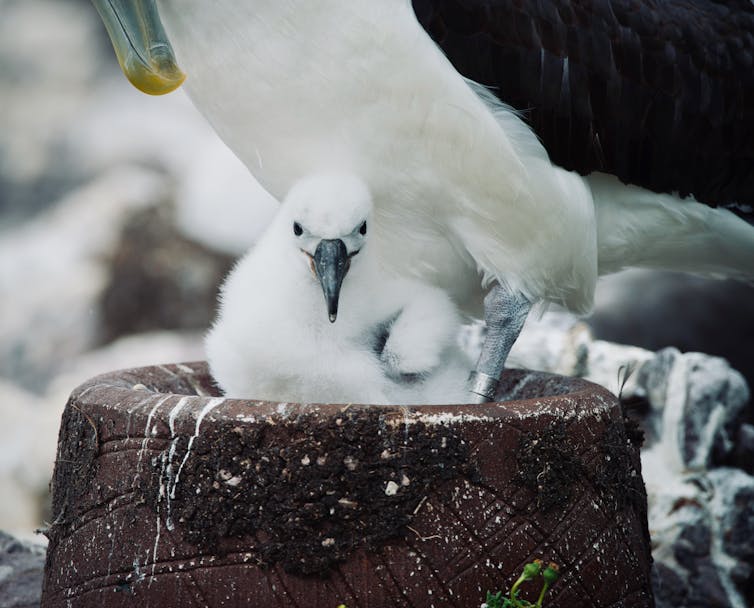
What Are Artificial Habitat Structures?
Animals rely on specific environmental features to survive, grow, reproduce and sustain healthy populations. Artificial structures seek to replicate these habitats.
Some artificial homes provide habitat for just one species, while others benefit entire ecological communities.
They’ve been built for a huge variety of animals across the world, such as:
boxes which mimic tree hollows, for beetles
nests made of coconut husks, for seabirds
nests made from mud brick and aerated concrete for the shy albatross
“hotels” based on fish traps, for seahorses
ceramic poles that provide a surface for spotted handfish to lay eggs
textured tiles attached to seawalls that provide habitat for up to 85 marine species.

How Do New Technologies Help?
More recently, wildlife conservationists have partnered with engineers and designers to incorporate new and exciting technologies into artificial habitat design.
For example, researchers in Queensland recently installed microchip-automated doors on nest boxes for brushtail possums.
The doors opened only for microchipped possums as they came close, and most possums were trained to use them in about 11 days. Such technology may help to keep predators and other animals out of nest boxes provided for threatened species.
In New Zealand, small, native lizards hide from predatory house mice in the crevices of rock piles. Researchers used video game software to visualise these 3D spaces and create “Goldilocks” rock piles - those with crevices big enough to let lizards in, but small enough to exclude mice.
3D printing to create artificial habitats is also becoming increasingly common.
Scientists have used a combination of computer simulation, augmented reality and 3D-printing to create artificial owl nests that resemble termite mounds in trees.
And researchers and designers have created 3D-printed rock pools and reefs to provide habitat for sea life.
It’s Not All Good News
Collaboration between scientists and engineers has enabled amazing new homes for wildlife, but there’s still lots of room for improvement.
In some instances, artificial habitats may be detrimental to an animal’s health. For example, they may get too hot or be placed in areas with little food or lots of predators.
And artificial habitats can become ineffective if not monitored and maintained.
Artificial habitat structures can also be used to greenwash environmentally destructive projects, or to distract from taking serious action on climate change and habitat loss.
Further, artificial habitat structures are often only feasible at small scales, and can be expensive to build, deploy and maintain.
If the root causes of species decline - including habitat destruction and climate change - aren’t addressed, artificial habitat structures will do little to help wildlife in the long-term.
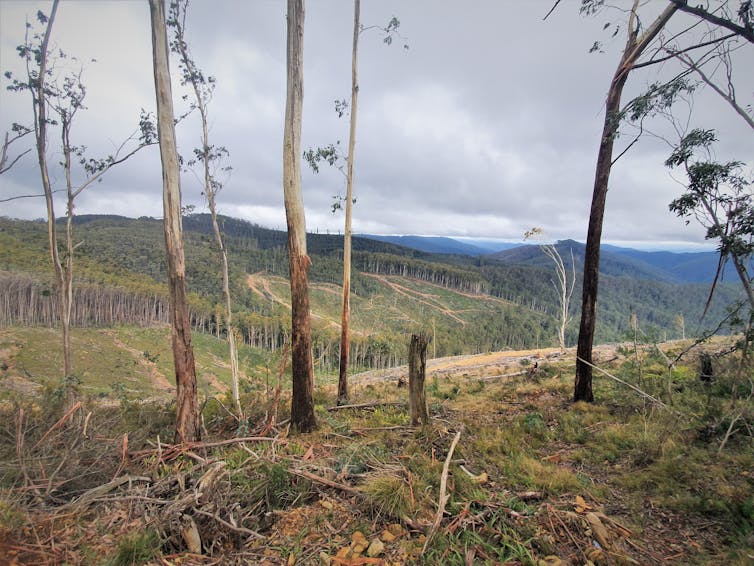
What Next?
It’s great that conservationists can create high-tech homes for wildlife – but it would be better if they didn’t have to.
Despite the dwindling numbers of countless species, environmental damage continues apace.
Native forests are cut down and rivers are dammed. Ocean shorelines are turned into marinas or seawalls and greenhouse gases are pumped into the atmosphere.
Such actions are the root cause of species decline.
We strongly encourage further collaboration between scientists and engineers to improve artificial habitat structures and help animal conservation. But as we help with one hand, we must stop destroying with the other.![]()
Darcy Watchorn, PhD Candidate, Deakin University; Mitchell Cowan, PhD Candidate, Charles Sturt University, and Tim Doherty, ARC DECRA Fellow, University of Sydney
This article is republished from The Conversation under a Creative Commons license. Read the original article.
In heatwave conditions, Tasmania’s tall eucalypt forests no longer absorb carbon

Southern Tasmania’s tall eucalyptus forests are exceptionally good at taking carbon dioxide from the atmosphere and converting it into wood.
For many years, we have believed these forests had a reasonable buffer of safety from climate change, due to the cool, moist environment.
Unfortunately, my research published today shows these forests are closer to the edge than we had hoped. I found during heatwaves, these forests switch from taking in carbon to pumping it back out.
That’s not good news, given heatwaves are only expected to increase as the world heats up. While we work to slash emissions, we need to explore ways to make these vital forests more resilient.
From Carbon Dioxide In To Carbon Out
It’s well established from forest sampling that moist, cool environments like southern Tasmania provide ideal growing conditions for tall eucalypt forests.
We had believed these types of forests would have a buffer against the worst effects of climate change to come, and perhaps even benefit from limited warming.
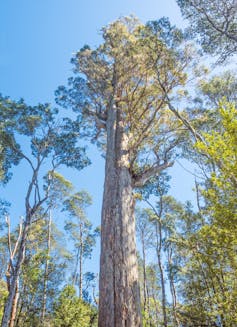
But this is no longer the case.
I monitored what happened to a messmate stringybark (Eucalyptus obliqua) forest during a three week heatwave in November 2017. Under these conditions, the forest became a net source of carbon dioxide, with each hectare releasing close to 10 tonnes of the greenhouse gas over that period.
A year earlier during more normal conditions, the forest was a net sink for carbon dioxide, taking in around 3.5 tonnes per hectare.
How can we know this? The forest I studied is at the Warra Supersite in the upper reaches of the Huon Valley, one of 16 intensive ecosystem monitoring field stations making up Australia’s Terrestrial Ecosystem Research Network.
Instruments mounted on an 80-metre-tall tower at Warra give us great insight into how the forest is behaving. We can measure how much, and how quickly, carbon dioxide, water and energy shuttle between the forest and the atmosphere.
So what actually happened in the forest during the hot spell? Two crucial things.
The first was that the forest breathed out more carbon dioxide. This was expected, because living cells in all air-breathing lifeforms (yes, this includes trees) respire more as temperatures warm.
But the second was very unexpected. The forest’s ability to photosynthesise fell, meaning less solar energy was converted to sugars. This took place while the trees were transpiring (releasing water vapour) rapidly.
Until now, we’ve seen falls in photosynthesis output in heatwaves because the trees are trying to limit their water loss. They can do this by closing their pores on their leaves (stomata). When a tree closes its stomata, it makes it harder for carbon dioxide in air to enter the leaves and fuel the photosynthesis process.
By contrast, this heatwave saw trees releasing water and producing less food at the same time.
So what’s going on? In short, the temperatures were simply too hot for the forests in southern Tasmania. Every forest has an ideal temperature to get the best results from photosynthesis. We now know this temperature in Australia is linked to the historic climate of the local area.
That means the trees at Warra require lower temperatures to optimally feed themselves, compared to most other Australian forests.
During the 2017 heatwave, the temperatures soared well outside the forest’s comfort zone. In the hottest part of the day, the forest was no longer able to make enough food to feed itself.
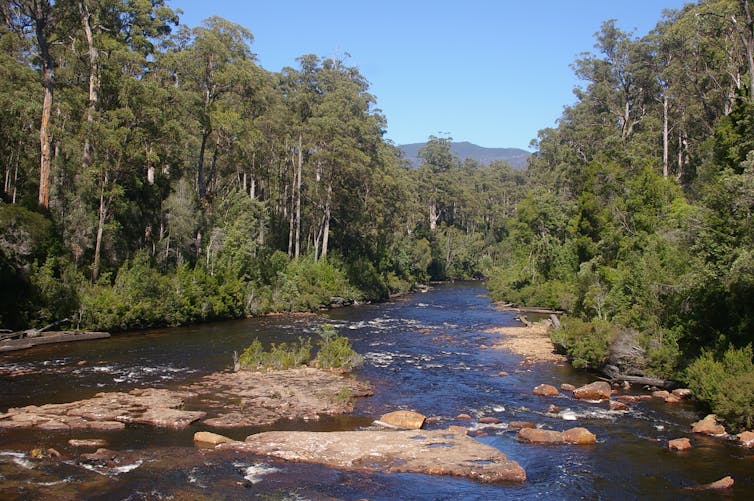
Outside The Forest’s Comfort Zone
For now, the forest at Warra is still intact. After the heatwave, the messmate stringybark forest quickly recovered its ability to feed itself, and became a carbon sink again.
But as the world warms, these forests will be pushed outside their comfort zones more and more. They can only endure so many of these kinds of heatwaves. If they keep coming, there will be a tipping point beyond which the forest can no longer recover.
What then? We can see a disturbing glimpse when we look at Tasmania’s oceans, which are a marine heatwave hotspot. Fully 95% of Tasmania’s giant kelp forests are now gone, killed off by temperatures beyond their ability to tolerate.

It is no exaggeration to say that the rapid increase in temperatures are the most serious threat to the health of tall eucalypt forests I’ve encountered during 40 years of studying forest health and threats in Tasmania.
Unlike the kelp forests, our tall eucalyptus forests have not yet hit their tipping point. We still have time to lessen the risk global heating poses.
There is already work under way to test promising new methods for making future forests better able to cope with the new climate they find themselves in.
These techniques include climate adjusted provenancing, where forest managers sow seeds of local species collected from areas at the hotter end of their range. Another being tried for giant kelp is finding individual plants with better heat tolerance and breeding them.
Our eucalyptus forests will need our help, more and more. The better engaged and informed we are about the risks to forests we long thought were highly resilient, the likelier we will be to be able to preserve them.
One way we could do this is by making our monitoring data publicly accessible in real time, so we can grasp the strain our forests are under as the world warms.![]()
Tim Wardlaw, Research Associate, University of Tasmania
This article is republished from The Conversation under a Creative Commons license. Read the original article.
'Blue Blob' Near Iceland Could Slow Glacial Melting
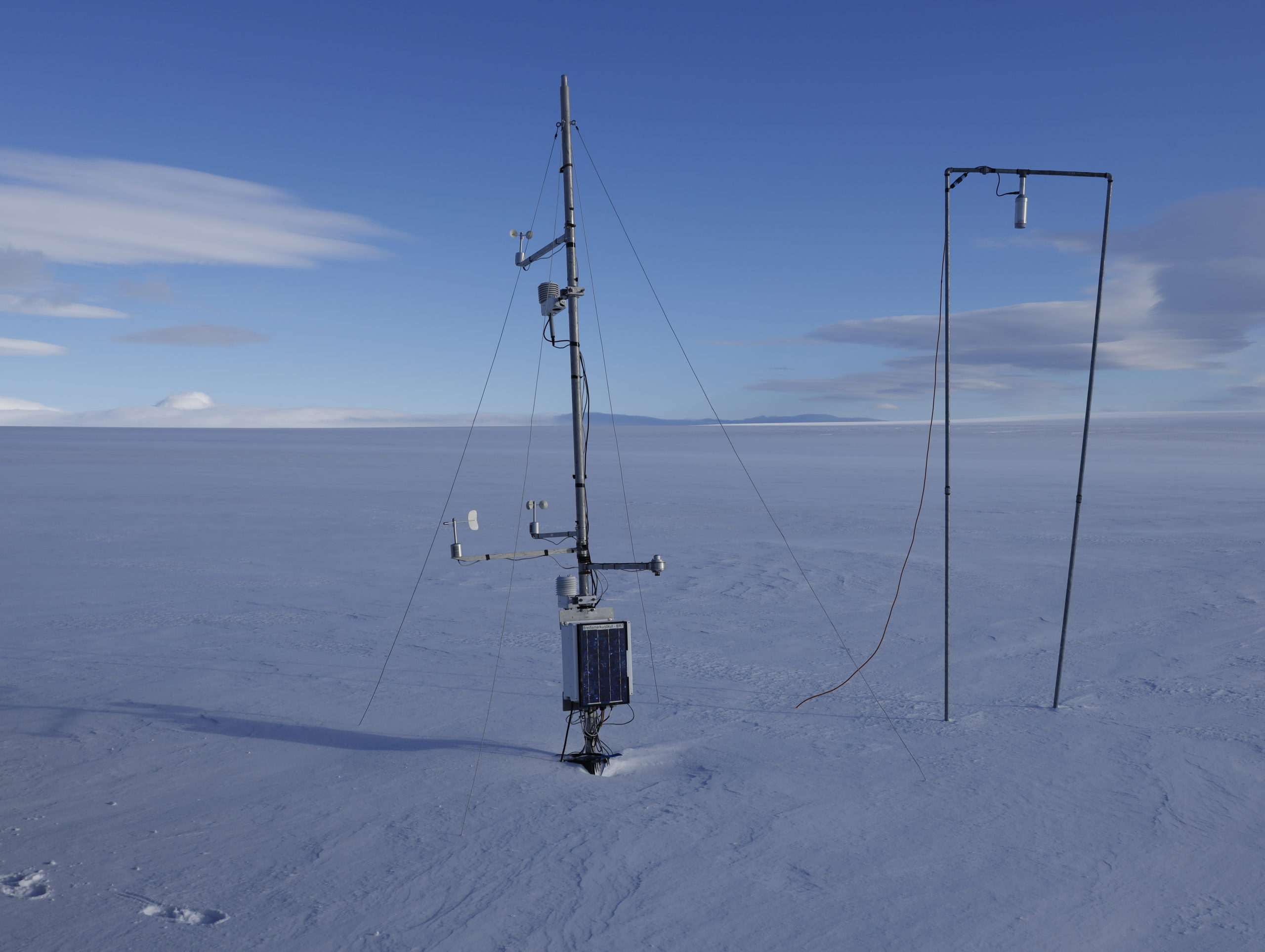
Lichens Are In Danger Of Losing The Evolutionary Race With Climate Change
.jpg?timestamp=1644964737161)
Oceans are better at storing carbon than trees. In a warmer future, ocean carbon sinks could help stabilise our planet

We think of trees and soil as carbon sinks, but the world’s oceans hold far larger carbon stocks and are more effective at storing carbon permanently.
In new research published today, we investigate the long-term rate of permanent carbon removal by seashells of plankton in the ocean near New Zealand.
We show that seashells have drawn down about the same amount of carbon as regional emissions of carbon dioxide, and this process was even higher during ancient periods of climate warming.
Humans are taking carbon out of the ground by burning fossil fuels deposited millions of years ago and putting it into the atmosphere as carbon dioxide. The current rate of new fossil fuel formation is very low. Instead, the main geological (long-term) mechanism of carbon storage today is the formation of seashells that become preserved as sediment on the ocean floor.
The continent of Zealandia is mostly submerged beneath the southwest Pacific Ocean but includes the islands of New Zealand and New Caledonia.
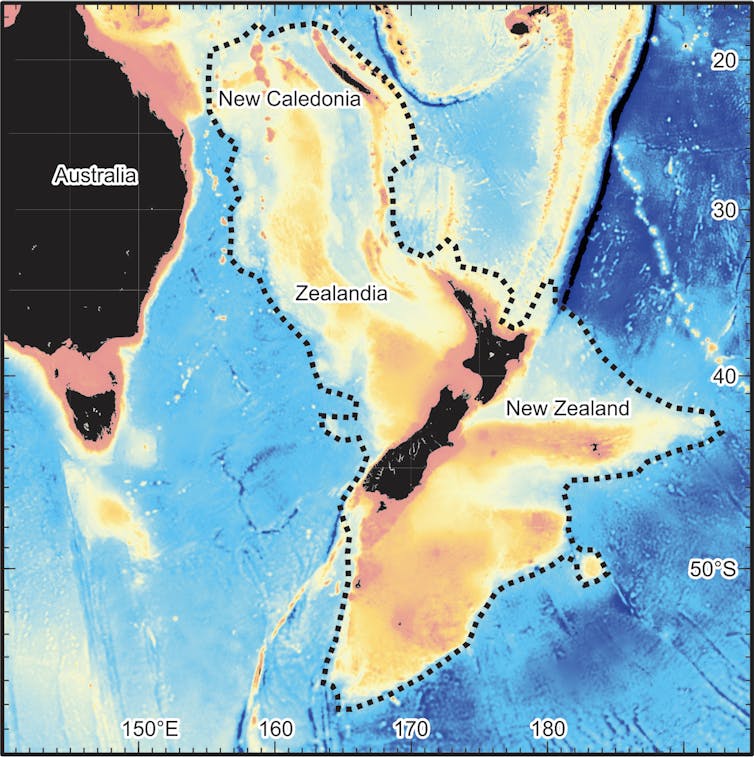
Carbon dioxide emissions from burning fossil fuels on the continent add up to about 45 million tonnes per year, which is 0.12% of the global total.
Our work documents a project that was part of the International Ocean Discovery Program (IODP). Expedition 371 drilled into the seabed of Zealandia to investigate how the continent formed and to analyse ancient environmental changes recorded in its sediments.
Drawing Carbon To The Ocean Floor
Organic carbon in the form of dead plants, algae and animals is mostly eaten by other creatures, mainly bacteria, in both the ocean and in forest soils. Most organisms in the ocean are so small (less than 1mm in size) they remain invisible, but as they die and sink, they transport carbon to the deep ocean. Their shells can accumulate on the seabed to make vast deposits of chalk and limestone.
The sediments we cored were many hundreds of metres thick and formed during warmer climates that might resemble the decades and centuries to come. We know the past environments from analysis of fossils.
Seashells, which are made of calcium carbonate, sequester significant amounts of carbon. The accumulation rate of shells averaged over the last million years was about 20 tonnes per square kilometre per year.
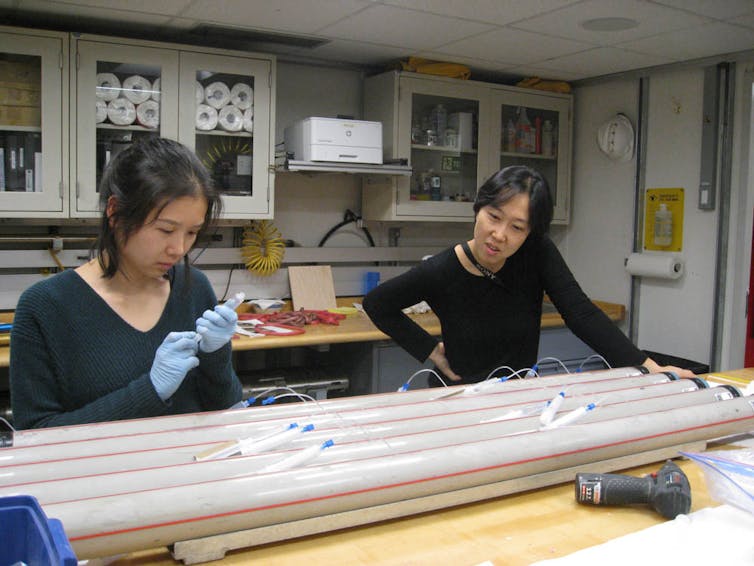
The total area of the Zealandia continent is about 6 million square kilometres, so the average rate of calcium carbonate storage was about 120 million tonnes per year, which is equivalent to 53 million tonnes of carbon dioxide per year.
This is about the same as emissions from burning fossil fuels on the continent today, within errors of calculation. However, a much larger area than just Zealandia is accumulating microscopic seashells.

The Planetary Carbon Cycle
Earth naturally expels carbon dioxide from mineral springs and volcanoes, as rocks are cooked at depth. This is unlikely to be affected by climate change. The Earth stores carbon dioxide when rocks are altered at the surface and as seashells accumulate on the seabed. Both these mechanisms might be affected by climate change.
The biosphere and oceans also hold significant carbon stocks that are sure to change. It is a complex system and many scientists are trying to understand how it will respond to human activities.
Different parts of the carbon system will respond in different ways and at different rates. Our work provides clues as to what might happen in the ocean.
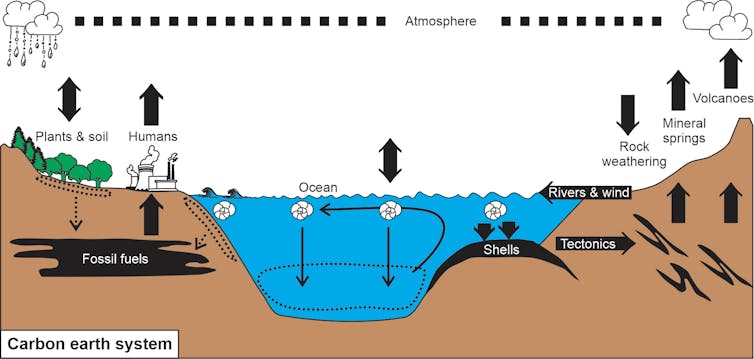
About 4-8 million years ago, the climate was warmer, carbon dioxide levels were similar or even higher than today, and the ocean was more acidic. However, we found the average accumulation rate of seashells on Zealandia was more than double that of the most recent million years.
This is a pattern seen elsewhere around the world. Warmer climates during this period had oceans that produced more seashells, but these data are average accumulation rates over million-year time scales.
The mechanism by which these ancient warmer oceans produced more seashells remains a subject of ongoing research (including ours).
Rivers and the wind deliver nutrients to the ocean, especially during extreme weather events, and changes can occur over short time scales. At the other extreme, fully integrated climate models show that large-scale reorganisation of ocean currents to enhance the supply of nutrients from deep waters could take centuries or even millennia.
Our work highlights and quantifies the important role the ocean, and particularly the microscopic life within it, will eventually play in restoring balance to our planet. The rate at which dead plankton draw carbon to the deep ocean and small seashells permanently store it on the seabed is a significant proportion of human carbon dioxide emissions and it is likely to increase in the future.
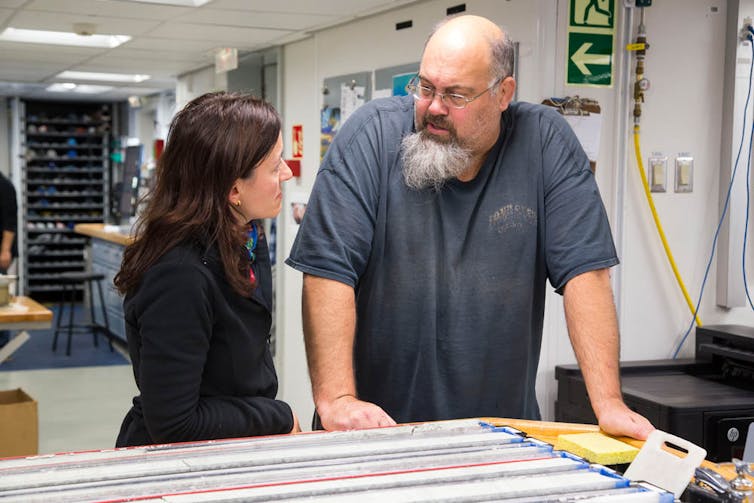
Our work reveals that a warmer ocean may eventually produce more calcium carbonate shells than today’s ocean does, even though ocean acidification will almost certainly occur.
How quickly natural carbon sequestration in the ocean might change remains highly uncertain. It will take many centuries before we reach an ocean state similar to that found 4-8 million years ago.
More work is needed to understand how this transition might occur and whether it is possible and sensible to enhance biological productivity in our oceans to mitigate climate change and maintain or increase biodiversity.![]()
Rupert Sutherland, Professor of tectonics and geophysics, Te Herenga Waka — Victoria University of Wellington and Laia Alegret, Professor in Paleontology, Universidad de Zaragoza
This article is republished from The Conversation under a Creative Commons license. Read the original article.
Sydney shark attack triggers calls for a cull – but let’s take a deep breath and look at the evidence
Daryl McPhee, Bond UniversityThe fatal shark attack off Sydney on Wednesday left the city shocked, and triggered questions from a horrified public. Why would a shark just grab a man from the water? And will it strike again?
The incident – Sydney’s first fatal shark attack since 1963 – has prompted debate on what to do next. Some people even took to social media to call for sharks to be culled.
This is a common community response following unprovoked shark attacks. But killing sharks is highly controversial. And as my research has shown, there are many non-lethal alternatives to protect beachgoers from sharks.
As authorities grapple with the best way to respond to this tragedy, it’s worth remembering all shark mitigation measures come with both merits and drawbacks – and none is a silver bullet.
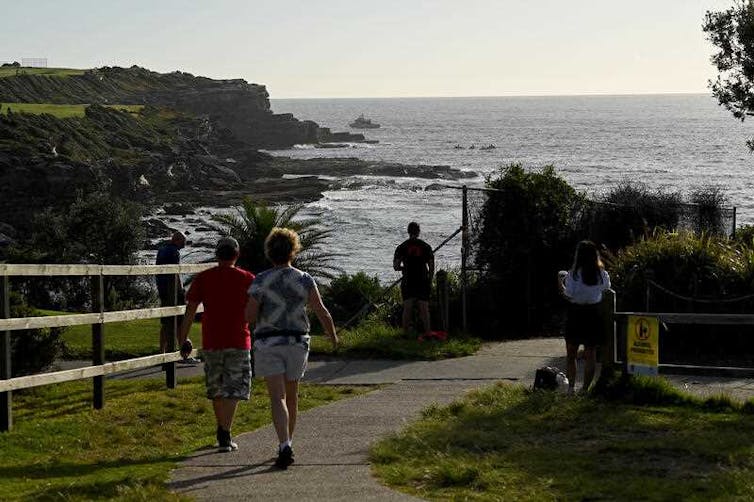
Killing Sharks Is Problematic
It’s unlikely authorities would ever be able to hunt down the individual shark involved in Wednesday’s fatality. As Macquarie University marine scientist Vanessa Pirotta has noted, sharks travel large distances and the animal is likely to be long gone.
Other times, members of the community call for an area-wide shark cull – and in rare cases a government will oblige.
In Western Australia in 2013, for example, the then Liberal government announced shark “kill zones” near beaches following a string of attacks. But the measure was scrapped after fierce opposition from the public and environment officials.
Any increased effort to kill sharks is likely to face public and political opposition, for several reasons.
First, sharks pose a low risk to humans. It’s true that globally, the frequency of unprovoked shark bites has increased, due to factors such as more water users and changes in shark distribution and behaviour.
But the probability of an unprovoked shark bite remains low.
Second, public perception towards sharks is changing. Many people now realise the intrinsic value of sharks and their important role in marine ecosystems.
Given all this, we must keep pursuing non-lethal methods to protect swimmers and surfers from sharks while avoiding environmental damage.
Let’s look at such approaches in more detail.
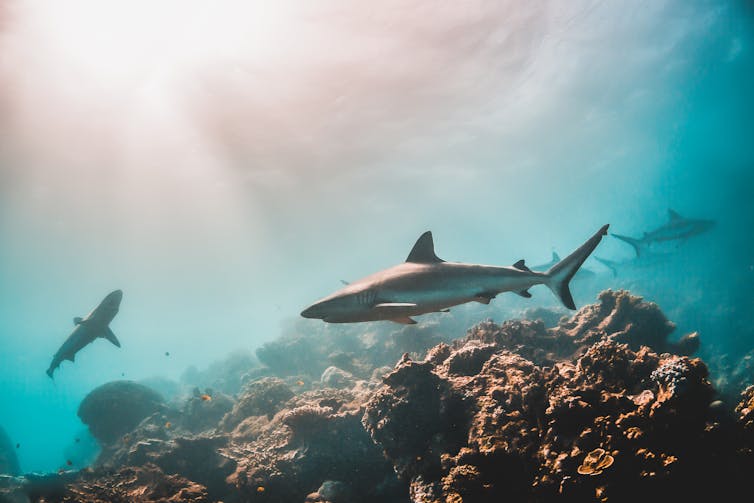
Aerial Surveys
Aerial surveys involve detecting sharks via a plane, helicopter or unmanned drone, or by people on land.
Their effectiveness can vary depending on how clear, calm or deep the water is, and on wind strength and shark behaviour.
An aircraft with human observers on board can survey a lot of coastline. But an aircraft can spend less than a minute on each beach, limiting the opportunity to locate a shark.
And research has shown even in reasonably clear water, overall rates of detection from planes and helicopters is low.
Drones cost less to operate than manned aircraft and are better for surveying a single location. However, battery constraints mean commercially available models can only stay airborne for a limited time.
In future, drones could be tethered to helium balloons or kites to allow for longer-term surveillance. But such technology is still at an early stage.
Surf patrol towers can help lifeguards detect sharks. But they must offer a vantage point more than 40 metres above sea level to be suitable for the task - a height well above that normally afforded by existing towers.

Nets And Drumlines
Sharks can be detected by capturing then releasing them. These methods include deploying either mesh nets or “drumlines” – baited hooks that lure sharks.
Shark nets operate at more than 50 NSW beaches in the warmer months. The program releases all live sharks caught in nets, but more than 80% of large “target” sharks caught in the nets die.
Traditional drumlines, used extensively in Queensland, also historically kill a significant proportion of sharks.
New “SMART” drumlines are designed to kill fewer captured animals. The device issues an alert when an animal is caught, and a contractor unhooks and relocates it.
Over three years of SMART drumline trials in NSW, high levels of live shark releases were reported. But the method requires extra labour expense to ensure rapid response to a capture.
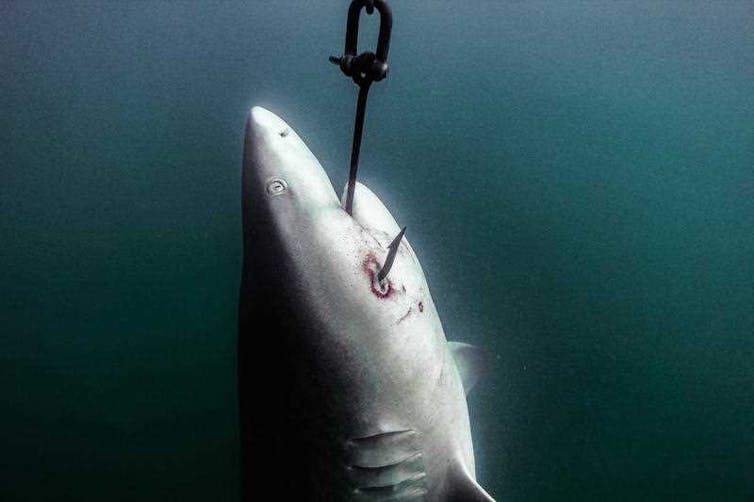
Area-Based Deterrents
Electrical shark deterrents have been investigated over many years. Research shows substantial promise, and Australia is making progress in commercialising the technology.
Scientists have investigated using acoustic deterrents such as orca calls and novel sounds to deter sharks. But such methods do not work on all shark species, and the impacts on other animals needs to be considered.
Physical barriers to exclude sharks from a particular area is a longstanding approach to protect bathers. Permanent swimming enclosures have worked in areas protected from exposed ocean conditions, such as Sydney Harbour.
But on ocean beaches, physical barriers must be designed to withstand constant wave energy, including extreme conditions. Previous attempted trials on NSW surf beaches failed as the gear either could not be installed, or was destroyed by the surf.
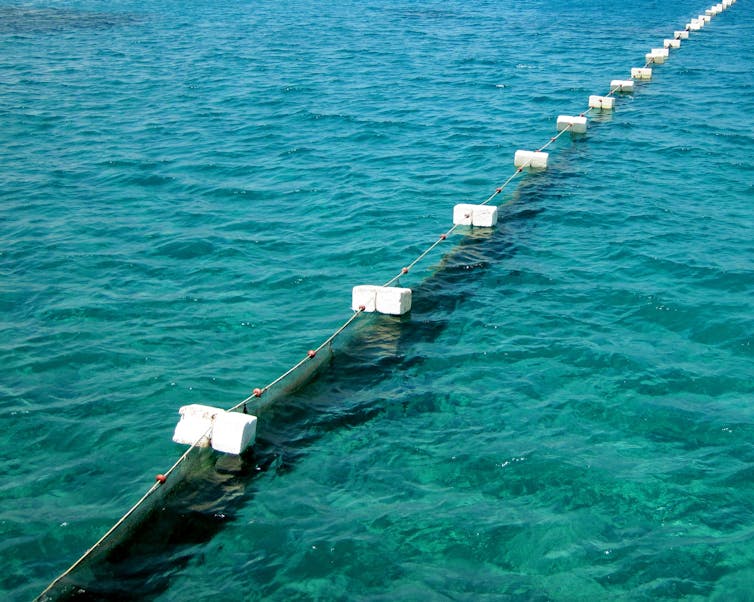
No Quick Fix
Wednesday’s fatal shark attack has understandably shaken the community and prompted debate. In all this, of course, we must remember that a human life has been lost.
Right now, talk of preventing future attacks will be of little comfort to the victim’s family and friends, eyewitnesses and first responders.
Looking further ahead, no system will ever deter or detect 100% of sharks. But risks can be reduced with well-considered approaches, suited to local conditions.
More research is needed into non-lethal strategies. The cost of various approaches is also an important consideration.
And no matter what system is used to protect beachgoers, it should be accompanied by efforts to educate the public about shark safety.
Tips include avoiding swimming or surfing in low light levels, avoiding beaches near estuaries after heavy rain and flooding, and avoiding places where stranded marine mammals are present – as the sites may attract sharks.![]()
Daryl McPhee, Associate Professor of Environmental Science, Bond University
This article is republished from The Conversation under a Creative Commons license. Read the original article.
Environmental footprint calculators have one big flaw we need to talk about

Are you one of the increasingly large number of people seeking to minimise the environmental damage wrought when producing the food you eat? If so, you might use the common “environmental footprint” method to decide what to buy.
Environmental footprints measure the environmental damage caused by a product throughout its life. For food, this includes the impacts of growing crops and livestock, and manufacturing the inputs required such as fertilisers. It can also include packaging and transport.
But unfortunately, environmental footprints often don’t tell the full story. When consumers switch to a food seen as more environmentally friendly, its production expands at the expense of other products. This has consequences that environmental footprints don’t take into account.
Environmental footprint calculators may promise to help consumers lead a greener life. But they may in fact encourage choices that don’t benefit – and may even harm – the environment.

A Problematic Assumption
We are experts in assessing the effectiveness of climate change mitigation for agricultural systems. We regularly provide policy advice to governments, United Nations bodies and other organisations.
The design of environmental footprint calculators is guided by international standards organisations and policymakers, including the European Union. The tool is commonly found on the websites of environmental groups, government agencies, companies and other organisations.
The calculators aim to guide consumer choice, by assessing the impacts of current production on the environment. But this is a problem.
It assumes the footprint of a product calculated today remains constant as production is scaled up or down, but this often doesn’t hold true. When demand for a product changes, this has knock-on effects on nature. It might mean more agricultural land is required, or river water is used to irrigate different crops.
Below, we examine three ways environmental footprints can provide a misleading picture of a product’s true impacts.
1. Land Use
Agriculture makes a large contribution to greenhouse gas emissions – primarily due to animal belches but also the production and use of synthetic fertilisers.
Organic farming can help reduce agriculture emissions, primarily because it doesn’t use synthetic fertiliser. But some research suggests converting to organic farming production could also exacerbate greenhouse gas emissions.
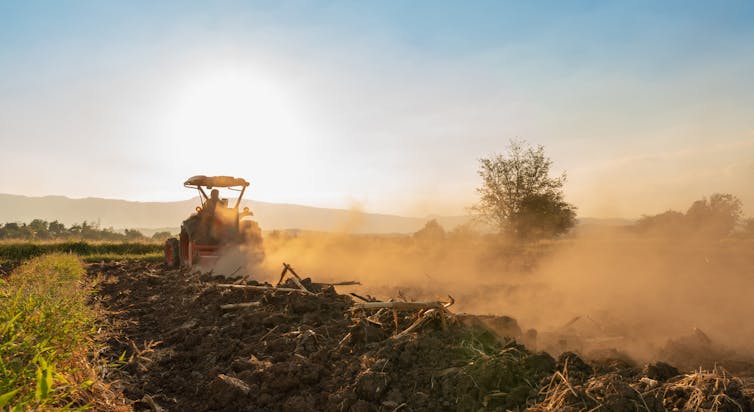
One study in England and Wales examined what would happen if all food production was converted to organic. It found global greenhouse gas emissions from food production could increase by about 60%.
This was because organic systems produce lower yields, meaning more crop and livestock production would be needed overseas to make up the shortfall. Creating this agricultural land would mean clearing vegetation, which emits carbon dioxide when it decomposes.
And when grasslands are converted to cropland, soil organic carbon is also lost. Enhanced soil carbon storage from organic farming offsets only a small part of the higher overseas emissions.
When considering the consequences of switching from one food to another, the type of agricultural land used is also important.
In Australia, about 325 million hectares of land is used to raise cattle to produce red meat. This land often can’t be used to grow crops because it’s too dry, steep, vegetated or rocky.
If consumers switch from red meat to plant-based diets, more land suitable for growing crops would be needed, either in Australia or overseas, to produce alternative proteins such as legumes or plant-based meats.
In Australia, existing arable land is already being used to supply crops to domestic and global markets. So new land would have to be made suitable for crops, either by cultivating grazing land or clearing forest. Alternatively, crop production could be increased by using more fertiliser or other inputs.
The emissions associated with these shifts are not included in carbon footprints of plant-based protein production.
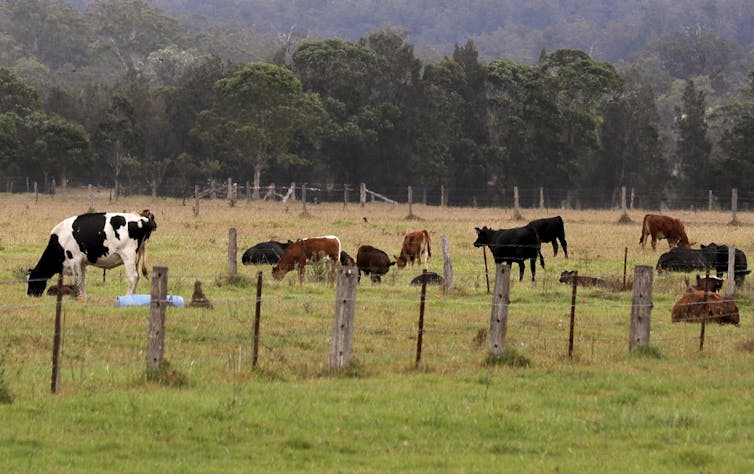
2. Water
It’s commonly assumed that choosing a product with a smaller water footprint will increase the water in rivers and lakes which replenishes the environment. However, in Australia, policy and markets determine how water is used.
Irrigation water can be traded between users. If a water-intensive crop such as rice is no longer grown, the farmer will almost always either use the water to grow a different crop or trade it with another farmer. In such a scenario, no water is returned to the environment.
Similarly, a fall in red meat production may not necessarily increase water for the environment.
Farmers whose land adjoins a river or other water body are allowed to take water for livestock to drink. Fewer livestock would leave more water available in rivers, but research in Australia suggests this water would be extracted for domestic uses, especially in dry years.
3. Goods Produced Together
Many agricultural products are produced in conjunction with others. For example, a cow slaughtered for red meat will also produce hide, meat meal and tallow. Likewise, a sheep can produce wool when alive, then other products when slaughtered.
So if consumers eschewed red meat due to its high carbon footprint, the associated products would also need to be replaced – and this would have environmental impacts.
If synthetic materials replace wool or hides, for example, demand for oil will likely increase. Or if wool is replaced with bio-based products such as cotton or hemp, demand for cropland will increase.

Increasing milk production per cow – and thus keeping fewer cows – has been considered as a way to reduce livestock emissions. But research suggests it may not have the intended result.
Fewer cows would produce fewer calves, which are used to produce veal. The research found less veal would require more red meat to be produced elsewhere, meaning no overall reduction in emissions.
It is realistic to assume that more red meat would be required. While per capita beef consumption is declining in some Western countries, global demand for beef is projected to increase to 2030 as wealth in developing countries increases and global population grows.
Towards A Healthier Planet
We and other experts are increasingly trying to raise awareness of the simplistic nature of environmental footprints.
It’s important to recognise the limitations of current methods and create tools that fully assess the consequences of consumers’ decisions.
Developing these tools will be challenging, due to the many uncertainties involved, and will require substantial research investment.
But it will lead to better environmental policy, fewer unintended consequences and a healthier planet. ![]()
Aaron Simmons, Adjunct Senior Research Fellow, University of New England and Annette Cowie, Adjunct Professor, University of New England
This article is republished from The Conversation under a Creative Commons license. Read the original article.
Avalon Golf Course Bushcare Needs You


Pittwater Reserves: Histories + Notes + Others
A History Of The Campaign For Preservation Of The Warriewood Escarpment by David Palmer OAM and Angus Gordon OAM
Angophora Reserve - Angophora Reserve Flowers
Annie Wyatt Reserve - A Pictorial
Avalon's Village Green: Avalon Park Becomes Dunbar Park - Some History + Toongari Reserve and Catalpa Reserve
Bairne Walking Track Ku-Ring-Gai Chase NP by Kevin Murray
Bangalley Headland Bangalley Mid Winter
Banksias of Pittwater
Barrenjoey Headland: Spring flowers Barrenjoey Headland after fire
Bayview Baths
Bayview Wetlands
Beeby Park
Bilgola Beach
Botham's Beach
Bungan Beach Bush Care
Careel Bay Saltmarsh plants
Careel Bay Birds
Careel Bay Clean Up day
Careel Bay Playing Fields History and Current
Careel Creek
Careel Creek - If you rebuild it they will come
Centre trail in Ku-ring-gai Chase National Park
Chiltern Track- Ingleside by Marita Macrae
Clareville Beach
Clareville/Long Beach Reserve + some History
Coastal Stability Series: Cabbage Tree Bay To Barrenjoey To Observation Point by John Illingsworth, Pittwater Pathways, and Dr. Peter Mitchell OAM
Cowan Track by Kevin Murray
Curl Curl To Freshwater Walk: October 2021 by Kevin Murray and Joe Mills
Currawong and Palm Beach Views - Winter 2018
Currawong-Mackerel-The Basin A Stroll In Early November 2021 - photos by Selena Griffith
Currawong State Park Currawong Beach + Currawong Creek
Deep Creek To Warriewood Walk photos by Joe Mills
Drone Gives A New View On Coastal Stability; Bungan: Bungan Headland To Newport Beach + Bilgola: North Newport Beach To Avalon + Bangalley: Avalon Headland To Palm Beach
Dunbar Park - Some History + Toongari Reserve and Catalpa Reserve
Dundundra Falls Reserve: August 2020 photos by Selena Griffith - Listed in 1935
Elsie Track, Scotland Island
Elvina Track in Late Winter 2019 by Penny Gleen
Elvina Bay Walking Track: Spring 2020 photos by Joe Mills
Elvina Bay-Lovett Bay Loop Spring 2020 by Kevin Murray and Joe Mills
Fern Creek - Ingleside Escarpment To Warriewood Walk + Some History photos by Joe Mills
Ingleside
Ingleside Wildflowers August 2013
Irrawong - Ingleside Escarpment Trail Walk Spring 2020 photos by Joe Mills
Irrawong - Mullet Creek Restoration
Katandra Bushland Sanctuary - Ingleside
Lucinda Park, Palm Beach: Some History + 2022 Pictures
McCarrs Creek
McCarr's Creek to Church Point to Bayview Waterfront Path
McKay Reserve
Mona Vale Beach - A Stroll Along, Spring 2021 by Kevin Murray
Mona Vale Headland, Basin and Beach Restoration
Mount Murray Anderson Walking Track by Kevin Murray and Joe Mills
Mullet Creek
Narrabeen Creek
Narrabeen Lagoon Catchment: Past Notes Present Photos by Margaret Woods
Narrabeen Lagoon State Park
Narrabeen Lagoon State Park Expansion
Narrabeen Rockshelf Aquatic Reserve
Nerang Track, Terrey Hills by Bea Pierce
Newport Bushlink - the Crown of the Hill Linked Reserves
Newport Community Garden - Woolcott Reserve
Newport to Bilgola Bushlink 'From The Crown To The Sea' Paths: Founded In 1956 - A Tip and Quarry Becomes Green Space For People and Wildlife
Pittwater spring: waterbirds return to Wetlands
Pittwater's Lone Rangers - 120 Years of Ku-Ring-Gai Chase and the Men of Flowers Inspired by Eccleston Du Faur
Pittwater's Parallel Estuary - The Cowan 'Creek
Riddle Reserve, Bayview
Salvation Loop Trail, Ku-Ring-Gai Chase National Park- Spring 2020 - by Selena Griffith
Stapleton Reserve
Stapleton Park Reserve In Spring 2020: An Urban Ark Of Plants Found Nowhere Else
The Chiltern Track
The Resolute Beach Loop Track At West Head In Ku-Ring-Gai Chase National Park by Kevin Murray
Towlers Bay Walking Track by Joe Mills
Trafalgar Square, Newport: A 'Commons' Park Dedicated By Private Landholders - The Green Heart Of This Community
Turimetta Beach Reserve by Joe Mills, Bea Pierce and Lesley
Turimetta Beach Reserve: Old & New Images (by Kevin Murray) + Some History
Turimetta Headland
Warriewood Wetlands and Irrawong Reserve
Whale Beach Ocean Reserve: 'The Strand' - Some History On Another Great Protected Pittwater Reserve
Winji Jimmi - Water Maze

New Shorebirds WingThing For Youngsters Available To Download
A Shorebirds WingThing educational brochure for kids (A5) helps children learn about shorebirds, their life and journey. The 2021 revised brochure version was published in February 2021 and is available now. You can download a file copy here.
If you would like a free print copy of this brochure, please send a self-addressed envelope with A$1.10 postage (or larger if you would like it unfolded) affixed to: BirdLife Australia, Shorebird WingThing Request, 2-05Shorebird WingThing/60 Leicester St, Carlton VIC 3053.

 Shorebird Identification Booklet
Shorebird Identification Booklet
The Migratory Shorebird Program has just released the third edition of its hugely popular Shorebird Identification Booklet. The team has thoroughly revised and updated this pocket-sized companion for all shorebird counters and interested birders, with lots of useful information on our most common shorebirds, key identification features, sighting distribution maps and short articles on some of BirdLife’s shorebird activities.
The booklet can be downloaded here in PDF file format: http://www.birdlife.org.au/documents/Shorebird_ID_Booklet_V3.pdf
Paper copies can be ordered as well, see http://www.birdlife.org.au/projects/shorebirds-2020/counter-resources for details.
Download BirdLife Australia's children’s education kit to help them learn more about our wading birdlife
Shorebirds are a group of wading birds that can be found feeding on swamps, tidal mudflats, estuaries, beaches and open country. For many people, shorebirds are just those brown birds feeding a long way out on the mud but they are actually a remarkably diverse collection of birds including stilts, sandpipers, snipe, curlews, godwits, plovers and oystercatchers. Each species is superbly adapted to suit its preferred habitat. The Red-necked Stint is as small as a sparrow, with relatively short legs and bill that it pecks food from the surface of the mud with, whereas the Eastern Curlew is over two feet long with a exceptionally long legs and a massively curved beak that it thrusts deep down into the mud to pull out crabs, worms and other creatures hidden below the surface.
Some shorebirds are fairly drab in plumage, especially when they are visiting Australia in their non-breeding season, but when they migrate to their Arctic nesting grounds, they develop a vibrant flush of bright colours to attract a mate. We have 37 types of shorebirds that annually migrate to Australia on some of the most lengthy and arduous journeys in the animal kingdom, but there are also 18 shorebirds that call Australia home all year round.
What all our shorebirds have in common—be they large or small, seasoned traveller or homebody, brightly coloured or in muted tones—is that each species needs adequate safe areas where they can successfully feed and breed.
The National Shorebird Monitoring Program is managed and supported by BirdLife Australia.
This project is supported by Glenelg Hopkins Catchment Management Authority and Hunter Local Land Services through funding from the Australian Government’s National Landcare Program. Funding from Helen Macpherson Smith Trust and Port Phillip Bay Fund is acknowledged.
The National Shorebird Monitoring Program is made possible with the help of over 1,600 volunteers working in coastal and inland habitats all over Australia.
The National Shorebird Monitoring program (started as the Shorebirds 2020 project initiated to re-invigorate monitoring around Australia) is raising awareness of how incredible shorebirds are, and actively engaging the community to participate in gathering information needed to conserve shorebirds.
In the short term, the destruction of tidal ecosystems will need to be stopped, and our program is designed to strengthen the case for protecting these important habitats.
In the long term, there will be a need to mitigate against the likely effects of climate change on a species that travels across the entire range of latitudes where impacts are likely.
The identification and protection of critical areas for shorebirds will need to continue in order to guard against the potential threats associated with habitats in close proximity to nearly half the human population.
Here in Australia, the place where these birds grow up and spend most of their lives, continued monitoring is necessary to inform the best management practice to maintain shorebird populations.
BirdLife Australia believe that we can help secure a brighter future for these remarkable birds by educating stakeholders, gathering information on how and why shorebird populations are changing, and working to grow the community of people who care about shorebirds.
To find out more visit: http://www.birdlife.org.au/projects/shorebirds-2020/shorebirds-2020-program
Aussie Bread Tags Collection Points

Australian First All-Female Surfing Series Launches: Challenge Her Team's Classic


Anne Dos Santos. Photo: Surfing NSW

Hunter Roberts. Photo: Surfing NSW

All In A Day's Work
Word Of The Week: Chortle
Military History Lesson On Offer For Students
Applications Now Open For NSW Youth Advisory Council 2022
Morning Of The Earth: 50th Anniversary Screening At Cremorne
Morning of the Earth 50th Anniversary screening with director Q&A Wed March 9 at the Hayden Orpheum Picture Palace, Cremorne. Beautifully remastered in 4K. One show only! Tickets: http://ow.ly/Rkhc30s774W
Deborah Harry - I Want That Man (HQ)
The International Space Station is set to come home in a fiery blaze – and Australia will likely have a front row seat

For more than two decades the International Space Station (ISS) has been the mainstay of human presence and research in space. More than 100 metres long, it’s the largest object ever placed in space, and its construction brought together the space agencies from the United States, Europe, Russia, Japan and Canada.
The ISS has hosted research that could not have been done anywhere else, in the fields of microgravity, space biology, human physiology and fundamental physics. It also provides a base for deep space exploration.
Now, the end of its life has been planned. According to NASA, the station is expected to be de-orbited by 2031 (an extension from the original plan to de-orbit by 2020). But if the ISS is so important, why is there an end-of-life plan at all?
In Short, The ISS Is Getting Old
The first components of the ISS were launched in the 1990s. And although many parts have been updated and replaced, it’s not feasible to replace everything.
In particular, the main structural components can’t be replaced. While they are checked, monitored and repaired, there are limits to this. The ISS was not designed to last forever.
It survives in a harsh environment, travelling at 27,500 kilometres per hour, with a day/night cycle every 90 minutes (the time it takes the ISS to orbit Earth).
The temperature differences experienced during each cycle put a small fatiguing load on the structure. Over a few years, this is not significant. But over the course of decades this can cause fatigue failures in the metal structure.
So there comes a time when the costs and risks of maintaining the ISS become too high, and this has been determined to be in 2030.
How Will The De-Orbiting Work?
As with all objects under the influence of gravity, given time the ISS would simply fall down to Earth. This is because, even at the orbital altitude of 400km, there is some drag due to small particles. In fact, the ISS currently requires a regular boost to lift its orbital altitude, which is slowly – but constantly – decreasing.
A natural re-entry would be a completely uncontrolled process, and there would be no way of predicting where this would take place. The responsible (and planned) approach is to use thrusters to slow the ISS down, causing the de-orbit to happen much faster and in a specific location decided in advance.
The slowing down will initially be done using thrusters on the station, and on support vehicles docked to the station. This process may take a few months and will slowly reduce the orbital altitude of the ISS, preparing it for the final re-entry phase.
In the final phase, the deceleration will be much more rapid, and will determine the ISS’s final re-entry trajectory. Although it hasn’t been decided exactly how the ISS will reach its final deceleration, the favoured option is to use three modified Russian Progress spacecraft.
The spacecraft will be docked to the ISS and fire their propulsion systems to achieve the required deceleration – controlling the trajectory of the re-entry and the re-entry location.
Artificial Fireballs
It will take a couple of minutes for the ISS to pass through the atmosphere. It’s likely the higher-altitude phase of this will take place near or above Australia.
The re-entry will be a visually spectacular event, resembling multiple large shooting stars. An increasing number of space debris breakup events have been observed and videoed over the last few years.
But these re-entries have been small objects, sized in the order of metres, such as the ATV-1 and Cygnus spacecrafts. Meanwhile, the ISS is about the size of a football field, and will be correspondingly more spectacular.

Crashing At Point Nemo
Due to the danger of components reaching the surface, it will be important to make sure they fall where there is minimal risk to people or property. Even a controlled re-entry will potentially spread pieces of debris over an area of hundreds, if not thousands, of kilometres.
This is why the ISS re-entry (and most space debris de-orbits) will target an area known as the South Pacific Ocean Uninhabited Area (SPOUA), the centre of which is known as Point Nemo, or the “Spacecraft Cemetery” .
The SPOUA is used as Earth’s dumping ground for space debris. It’s the largest uninhabited area on Earth, and hence has the lowest risk associated with debris from re-entry.

The ISS will be travelling at something like 6km per second when it hits the atmosphere. This high speed will cause the air in front of the structure to heat up significantly, reaching temperatures in excess of 10,000℃.
This will cause the structure to break into smaller pieces. Most of it will burn up as it falls, but it’s very likely some small pieces will survive – especially some of the heavier and denser internal components.
Any surviving debris will eventually sink into the ocean and disappear.![]()
Fabian Zander, Senior Research Fellow in Aerospace Engineering, University of Southern Queensland
This article is republished from The Conversation under a Creative Commons license. Read the original article.
I helped introduce silver medallist Jaclyn Narracott to the fearsome 130kph skeleton event. Here’s how it’s done
Dale Chapman, Curtin UniversityAustralian Jaclyn Narracott admits it took a significant change of mindset to help her claim silver at the Beijing Winter Olympics in the women’s skeleton – the bobsled event in which competitors hurl themselves down a curving track at speeds of 130 kilometres per hour, with mere centimetres between their chin and the ice.
I was part of the coaching team that introduced her to this event more than a decade ago, in March 2011 at Lake Placid, New York, the venue for the 1980 Winter Olympics. I was the sport scientist and program manager of the Olympic Winter Institute of Australia’s Skeleton Program, along with my colleagues from the Australian Bobsleigh Skeleton Association (now Bobsleigh Skeleton Australia).
These days, Jacklyn splits her training time between sunny Queensland, at the Queensland Academy of Sport, and training with her partner in the UK during the off-season. On-ice training happens either during the northern summer in an “ice push house” – an indoor facility that lets athletes practise the start component of the event – or during the northern winter at one of just 15 tracks worldwide.
So what does it take to produce a medal-winning performance? And, perhaps more intriguingly, how does someone even begin to learn this fearsome sport?
What Is Skeleton?
Skeleton racers ride along a banked, ice-covered track, lying face-down on a single-piece sled with no suspension, no steering and no brakes. It’s a bumpier ride than it looks – ice isn’t smooth when you’re travelling faster than a car on a freeway!
Unlike the related events of bobsleigh, in which athletes sit inside a sled with steering cables attached to the front runners, and luge, in which competitors lie on their backs and use their legs to activate steering paddles, a skeleton sled is steered mainly by applying pressure via the knee or shoulder, or by subtly shifting the head or body position.
How Do You Win?
Olympic skeleton athletes make four runs down the track, which is typically 1.2km long and features about 20 corners, with the fastest cumulative time taking the gold.
The overall speed depends on three things: the momentum generated during the short running start; the kinetic energy supplied by gravity as athletes descend along the course and by centrifugal force as they round the corners; and how effectively competitors can conserve energy by taking the most efficient line through the corners.
In general, athletes prefer to steer using their knee, shoulder or both. Steering left, for example, would involve pressing the right shoulder or left knee down onto the sled, or both at once for a sharper turn. This flexes and twists the sled, affecting the direction of the runners.
When approaching a corner, both the entry point (either early or late into the corner) and the direction of the sled affect how the centrifugal force of the corner will act on the slider. The athletes seek to anticipate the centrifugal force in the corner, to stick to a natural flowing line so as to carry more speed through the corner exit. Dragging a toe along the ice, while very effective for changing direction, can cost a lot of speed, so generally racers avoid this move where possible.
In straight sections of track, where there is no centrifugal force, steering the sled in the usual way doesn’t work, but a subtle tilt of the head can create an “air dam” that slightly changes the sled’s direction. But you don’t want to break the sled into a power slide skid, as you will lose a lot of momentum.
Finding an aerodynamic position is relatively straightforward: arms and hands by the competitor’s sides or tucked slightly under the top of the thighs; legs together and toes slightly pointed to remain off the ice. The head and chin are not tucked down, but instead held in a neutral position to maintain a clear view down the track.
As athletes develop, they become comfortable in this sliding position despite the alarming proximity of face and ice.

Ok, But How Do You Learn?
An athlete’s approach to skeleton depends on what we sports scientists call their “fear/risk profile”. This is an analytical tool that can help any athlete who may need to deal with significant fear or risk in their chosen event. It can boost confidence by allowing athletes to describe and contextualise their previous experiences of a track, with reference to particular weather or ice conditions.
When first learning this discipline, all skeleton sliders will begin from a lower position in the track, and only navigate the final six or so corners. This reduces both the speed and complexity of the run. At Lake Placid a decade ago, Jaclyn began her first ever run from corner 10 and completed four runs that day, before moving up to corner 7 the next day.
This might sound like a very small amount of practice for such a complex sport, but the on-ice vibrations and the g-forces involved are very fatiguing. After training, some athletes can show symptoms similar to impact trauma without having suffered any actual impact.
Their coach will then ask them to describe their entrance and exit from each corner, when and where they steered, and what steering technique they used. Using visual and video feedback, the athlete and their coach reviews their performance, thus building their risk profile and improving their speed.
As the athlete improves, they move further up the track to include more corners and greater speeds, until eventually they have mastered the entire course. But an experienced slider like Jaclyn will tackle a new course from the top straight away, as they have the necessary skills and confidence.
To cement their performance and learning, athletes take detailed track notes which they use to perform “mind runs”, either purely by mentally picturing the descent, or while lying on their sled and rehearsing the moves in the correct sequence.
And Finally, How Do You Stop?
As mentioned above, a skeleton bobsled has no brakes. Bobsled courses generally have a long uphill ramp beyond the finish line, and competitors can also drag their spiked shoes along the ice or aim to rub off speed by steering into the walls of the track. After crossing the finish timing eye, the finishing straight or “outrun” of a track is usually about 100m long.
Stopping comes with its own risk of injury – athletes have fallen off their sleds, usually bruising nothing more than their ego, but occasionally something may be tweaked or broken. But compared with the challenge of successfully navigating a succession of corners at speeds faster than a car on a freeway, stopping is the relatively easy part.![]()

Dale Chapman, Senior Lecturer, Applied Sports Science, Curtin University
This article is republished from The Conversation under a Creative Commons license. Read the original article.
Want to delete your social media, but can’t bring yourself to do it? Here are some ways to take that step

For more than a decade we’ve been deeply immersed in a love affair with social media. And the thought of ending things can be painful. But like any relationship, if social media is no longer making you happy – and if curating your online persona is exhausting instead of fun – it might be time to say goodbye.
Late last year, Meta (previously Facebook) came under intense scrutiny after leaked documents revealed the company was fully aware of the negative impact its products, Instagram in particular, can have on users’ mental health.
Meta went straight into damage control. But it seemed no one was particularly surprised by the news – not even teenage girls, who Meta identified as most at risk. Was the leak just confirming what we already suspected: that social media has the potential to be much more harmful than helpful?
How did our once carefree relationship with social media turn sour? And perhaps most importantly, can (or should) it be salvaged?
Spotting The Red Flags
Relationship counsellors will often ask troubled couples to think about what made them happy in their relationship. Social media, for all it’s annoying peccadilloes, does have some redeeming features.
Throughout the pandemic, the ability to stay connected to people we can’t see in person has become incredibly valuable. Social media can also help people find their tribe, particularly if the people in their offline world don’t share their values and beliefs.

But if you can’t go a day without trawling through the sites, feeling compelled to “like” or be “liked”, your relationship is in trouble.
Though far from settled, the bulk of screen time research focuses on the detrimental effects of excessive or problematic screen use on well-being and mental health. A 2021 meta-analysis of 55 studies, with a combined sample size of 80,533 people, found a positive (albeit small) association between depressive symptoms and social media use.
An important finding was that negative consequences were more likely to come from how social media use made participants feel, rather than how long they used it.
Information Overload
In trying to understand why social media can leave us feeling less than content, we can’t look past the effect of the 24/7 news (and fake news) stream on our collective psyche.
A 2021 Deloitte survey of Australians found 79% thought fake news was a problem, and only 18% felt information obtained via social media was trustworthy. Having to navigate content that deliberately aims to perpetuate fear and dissent only adds to people’s cognitive and emotional burden.
But here’s the rub. It seems while we’re generally concerned about technology having a negative impact on our well-being, this doesn’t translate to behaviour change on an individual level.
My own research published last year found more than two-thirds of survey participants believed excessive smartphone use can negatively impact well-being, yet individual usage was still very high, averaging 184 minutes per day. There was no relationship between the belief and the behaviour.
What leads to this apparent cognitive-behavioural dissonance? The results of a long-term study by University of Amsterdam researchers might provide a clue. They found living in a “permanently online” world leads to decreased self-control over social media use and, subsequently, lower well-being.
In other words, we know what we’re doing might be bad for us, but we do it anyway.
Simple Steps You Can Take
How do you know when it’s time to reevaluate your relationship with social media? There’s one deceptively simple question to ask yourself: how does it make you feel?
Think about how you feel before, during and after you use social media. If you feel like you’re wasting large chunks of your day, your week (or, dare I say, your life) on social media - that’s a clue. If you feel negative emotions such as sadness, anxiety, guilt or fear, you have your answer.
But if divorcing social media abruptly feels like a step too far, what else can you do to slowly break away, or potentially salvage the relationship?
1. Start with a trial separation
A “soft delete” lets you see how you’ll feel without your social media before committing to a hard delete. Let friends and family know you’re taking a break, remove the apps from your devices, and set yourself a goal of maybe one or two weeks where you don’t access the account/s. If the world is still turning at the end of this trial, keep going! Once you no longer feel the pull of social media, you’ll be ready to hit delete.
2. Reduce the number of platforms you engage with
If you have Facebook, Instagram, Twitter, TikTok, YouTube, Snapchat, WhatsApp, Tumblr, Pinterest and Reddit on your phone, tablet and computer, you’re probably past saturation point and into drowning territory. Pick one or two apps that genuinely serve a meaningful purpose for you, and ditch the rest. Gen X’ers find it hard to say goodbye to Facebook, but Gen Z have largely bid it farewell. If they can do it, so can you!
3. If steps 1 and 2 are still too much, try to reduce your time spent on social media
First and foremost, turn off all your notifications (yes, all of them). If you’re conditioned to respond to every “bing”, you’ll find it almost impossible to stop. Set aside some time each day and do all your social media catching up or browsing. Set an alarm for your predetermined time allocation, and when it sounds, put the phone down until the same time tomorrow.
None of this will be easy, and walking away from social media might hurt at first. But if the relationship has become uncomfortable, or even abusive, it’s time to take a stand. And who knows what untold happiness you might find, beyond the four walls of your screen?![]()
Sharon Horwood, Senior lecturer in Psychology, Deakin University
This article is republished from The Conversation under a Creative Commons license. Read the original article.
Quokka-sized fossil species show kangaroos evolving to eat leaves – for the fourth time

Kangaroos have such a taste for leaves that they have evolved the ability to eat them on at least four separate occasions during their evolutionary history, a new fossil discovery reveals.
Today, there are more than 60 species of kangaroos, wallabies, bettongs and rat-kangaroos living throughout Australia and New Guinea. But their diversity in time is even more incredible: just 100,000 years ago, Australia had many species of giant kangaroos, including the giant short-faced kangaroos which, bizarrely enough, didn’t hop but instead walked rather like a theropod dinosaur such as Velociraptor.
Going further back in time, to around 20 million years ago, there were plenty more interesting kangaroos, some of which were direct ancestors of today’s species. Generally, these species were no larger than a wallaby, but they were impressively diverse, including kangaroos with fangs, kangaroos that could eat meat, and more besides.
We know all this thanks to the amazing fossils discovered at Riversleigh World Heritage Area in north-western Queensland – arguably Australia’s most celebrated fossil location. So far, around 30 species of prehistoric kangaroos have been found here. And the two most recently discovered ones add another interesting twist to their evolutionary tale.
Our latest discovery, published today, names two new species of ancient kangaroos: Gumardee webbi and Gumardee keari, which lived alongside one another around 18 million years ago in the Riversleigh rainforest.
They are represented by a few partial skulls and several jaws, which can tell us a lot about the biology of these extinct animals.
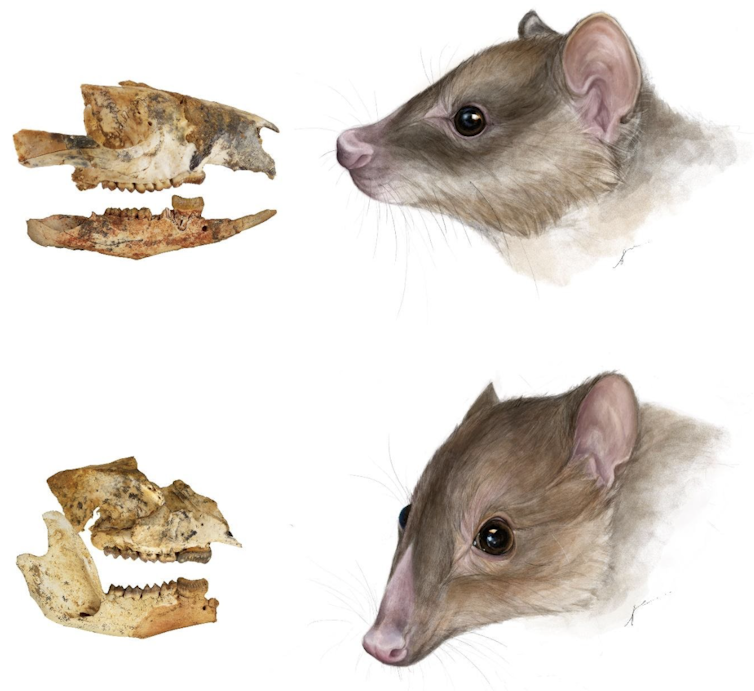
These kangaroos would each have weighed 3–4 kilograms, roughly the size of a quokka. But what’s most intriguing about them is their teeth. The pattern of blades on their molars is best suited to eating leaves from trees and bushes. This is surprising, because their ancestor, Gumardee springae, which lived around 6 million years earlier at the same location, had teeth better suited to a wider range of foods such as fruits, fungi and insects.
Two previously discovered species, Gumardee pascuali and Gumardee richi, were intermediate to these two groups, both in terms of their evolutionary age and the patterns of their teeth. This means the Riversleigh fossils, taken together, reveal the evolutionary process of kangaroos’ teeth changing and adapting to different foods.
A Taste For Leaves
Remarkably, this is not the first time this has happened in the fossil record of kangaroos. In the late 1990s and early 2000s, the late palaeontologist Bernie Cooke studied Riversleigh’s kangaroos in great detail and discovered that the ancestors of modern kangaroos were generalists, eating mostly forest fruits, fungi and insects, and slowly evolved the ability to eat leaves over time.
Today, kangaroos and wallabies only eat leaves from bushes or grass, whereas rat-kangaroos, bettongs and potoroos eat fungi, fruits and insects, similar to ancient kangaroos.
He even demonstrated that another family of ancient kangaroos at Riversleigh, the fanged kangaroos, independently evolved the same ability to eat leaves at roughly the same time.
Another independent evolution of leaf-eating was also identified from fossil sites in South Australia – the third documented instance in kangaroos.
The two new species discovered at Riversleigh therefore now represent the fourth time leaf-eating has been seen to develop in the kangaroo fossil record.
Competition In The Rainforest
Only one of these four groups (the Riversleigh species studied by Cooke) is a direct evolutionary ancestor of today’s kangaroos and wallabies. The other three groups that pioneered leaf-eating all eventually died out: the South Australian species around 23 million years ago; the Gumardee group around 15 million years ago; and the fanged kangaroos around 10 million years ago.
The obvious questions that arises are: why did these groups all die out, and does this mean today’s kangaroos and wallabies have evolved to eat a risky and highly specialised diet?
We know their ancestors ate fruits, fungi and insects, but then again so would have many other species of marsupials, such as bandicoots and possums. In fact, there were so many of these various marsupial competitors that would have made evolutionary sense for ancient kangaroos to branch out into other foods – particularly leaves, which would have been available all year round, as opposed to seasonal fruits.
So why didn’t they survive? They weren’t the only ones evolving the ability to eat leaves at the time. It happened in possums, koalas and wombats, so the competition was tough.
We have always known Australia is a tough place to survive. Riversleigh’s fossils, which span more than 10 million years of Australia’s evolutionary history, shows just how tough it would have been.![]()
Kenny Travouillon, Curator of Mammals, Western Australian Museum
This article is republished from The Conversation under a Creative Commons license. Read the original article.
Yes, words can harm young trans people. Here’s what we can do to help

All children and adolescents have the right to live free from discrimination. However, the public debate last week around the proposed religious discrimination bill threatened this right.
While the bill has been shelved, the debate is a continuation of a discussion in which the existence, rights, and lives of trans children and adolescents have been called into question both in Australia and overseas.
These young people have endured intensified stigma and discrimination that negatively impacts their health and well-being.
Poorer Health Outcomes
Trans people make up between 2.3% to 3.7% of Australia’s youth population.
Although many trans people live healthy, fulfilled lives, research from overseas shows a disproportionate number have poorer mental health than their peers.
Recent Australian studies paint a similar picture. One study found:
- 90% of trans young people experienced high or very high psychological distress in the previous four weeks
- 54% had self-harmed
- 71% reported suicidal ideation
- 14% had attempted suicide in the preceding 12 months
- 38% reported having attempted suicide at some point in their life.
Another study found trans young people in Australia were 15 times more likely to attempt suicide than the general population.
Minority Stress
Minority stress arises from the social, psychological and structural discrimination associated with belonging to a stigmatised minority group.
Negative media commentary can directly contribute to minority stress among trans people, as can legislation and policies that seek to exclude trans individuals from schools and workplaces.
Negative representations of trans children and adolescents in the media shape public attitudes and practices. This can not only stoke fear and mistrust that further marginalises trans young people, but also lead to violence against them.

In Australia, one study found 89% of trans young people had experienced peer rejection. Some 74% had experienced bullying, while 69% had experienced discrimination.
Another study found 68% of trans young people in Australia had felt uncomfortable or unsafe in their educational setting because of their gender or sexuality diversity.
A third study found young trans Australians were four times more likely to have experienced sexual violence or coercion.
Public debate about trans young people also impacts their families. For instance, a recent study reported parents of trans children and adolescents in the United States experienced significant stress as a result of legislation introduced to prevent young trans people accessing medical and surgical gender affirmation.
Not surprisingly, parents viewed these bills as increasing stigma towards their child and the broader trans community.

Health Harms Of Public Debate
Apart from fostering stigma and discrimination, public debate about trans people can also negatively impact their health.
Physical activity in adolescence is important for long-term health. Trans young people already experience multiple barriers to participating in sport and physical activity. Public commentary questioning involvement of trans people in sport acts as a further obstacle.
Negative press coverage about affirmative health care for trans young people has also been associated with reduced referral rates to specialist paediatric gender clinics overseas, and highlights the role public debate is likely to play in reducing access to such care.
Finally, trans young people report exposure to negative news stories adversely affects their mental health by provoking experiences of depression, anxiety, and/or fear.
So What Can We Do To Help?
Strikingly, previous research has shown when trans young people are supported and their gender is affirmed, they have similar mental health outcomes to their cisgender peers.
While parental support no doubt plays a key role, emerging evidence indicates having safe and supportive schools is critical too.
School safety and connectedness, for example, are protective factors against depression, self-harm, and suicide.
Similarly, peer and school support provide a buffer against the negative impact of gender-related victimisation on mental health.
Policies and procedures that enable a trans young person’s gender, name and pronouns to be accurately recorded are also important. Research shows having identity documents that match one’s affirmed gender is associated with lower rates of serious psychological distress and suicide.
Finally, the media itself may help to promote better health for trans young people. For instance, trans adolescents have reported experiencing happiness and increased hope after exposure to positive news reports about other trans people.
Trans young people flourish with support from family, friends, and the broader community. Hopefully, future commentary about trans young people’s rights takes this into account.![]()
Cristyn Davies, Research Fellow in Child and Adolescent Health, Faculty of Medicine and Health, University of Sydney; Alessandra Chinsen, PhD candidate, Murdoch Children's Research Institute; Ken Pang, Team Leader, Murdoch Children's Research Institute; Kerry H. Robinson, Professor in Sociology, School of Social Sciences, Western Sydney University, and Rachel Skinner, Professor in Paediatrics, University of Sydney
This article is republished from The Conversation under a Creative Commons license. Read the original article.
The new Lord of the Rings prequel, The Rings of Power, is set in the Second Age of Middle-Earth - here’s what that means
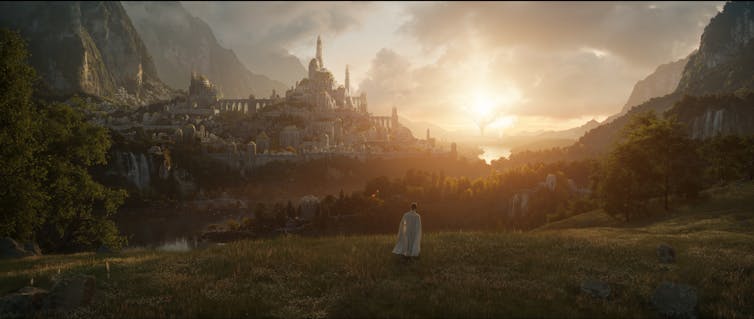
Amazon Studios is due to launch its Lord of the Rings prequel TV series in September this year. Not much is known about it yet, other than the title – Lord of the Rings: the Rings of Power, some first looks, a teaser-trailer, and that it will be set in the Second Age of J.R.R. Tolkien’s Middle Earth timeline.
The Second Age will not be all that familiar to audiences of Peter Jackson’s film adaptations of Tolkien’s novels, which take place in the Third Age, many thousands of years after the events featured in The Rings Of Power. But the books, including Lord of the Rings, The Silmarillion, and the lore-heavy Unfinished Tales and The History of Middle-Earth provide us lots of background to the history of the Second Age.
What follows is a quick primer on this setting and what we can expect from the Amazon series.
What Is The Second Age?
The Second Age begins after the downfall of Morgoth (a Lucifer figure in Tolkien’s mythology) and ends with the first defeat of Morgoth’s lieutenant Sauron, which film audiences will remember from the opening montage of the Fellowship of the Ring, where an alliance of men and elves defeat the dark lord by cutting the source of his power, the One Ring, from his finger.
None of Tolkien’s books focus specifically on the Second Age, though key events are briefly detailed in the last sections of the Silmarillion and some stories from Unfinished Tales. Tolkien’s lengthily appendices to the Lord of the Rings provide a full timeline of the Second Age. These fragments describe a time when the elves were more prominent and powerful, and human kingdoms were greater and more unified.
The Second Age serves as a lost classical period that falls between the heroic myth-cycle that depicts the events of the First Age in the Silmarillion, and the grittier medievalism of the Third Age that we see in the Lord of the Rings.

What Happens In The Second Age?
Perhaps the most important event is the forging of the rings of power. A disguised Sauron tricks the elven smith Celebrimbor into forging nineteen rings to be distributed between elves, dwarves and humans.
However, the elves quickly realise that this is a ploy by Sauron to control them all through the power of the One Ring and begin a long battle against his influence.
Given its title, the series will probably focus on the consequences of falling prey to the power of the rings. It might well depict the origins of the Nazgûl, or ringwraiths, the undead servants of Sauron in the Lord of the Rings, who first emerge in the Second Age.

What Else?
Promotional images include a map of the island of Númenor, a land given to humans who fought against Morgoth. In the Second Age it becomes a great naval power, creating colonies and settlements on the main continent.
Eventually Númenor joins the war against Sauron and takes the dark lord captive. However, Sauron corrupts their king, Ar-Pharazôn, and convinces him to invade the western land of Valinor, home to the angelic Valar, in pursuit of immortality. In retribution, the Valar sink the island of Númenor into the ocean.
Tolkien first conceived of Númenor in the Lost Road, an abandoned novel about time travellers witnessing the fall of Atlantis, but it really works as an analogue to Rome within the history of Middle Earth: a broken empire that is eventually succeeded by fragmented kingdoms.
The survivors of Númenor later join with the elves to defeat Sauron and found Gondor and Arnor.

What’s Arnor? Tell Me About Arnor!
Arnor is established towards the end of the Second Age as a sister-kingdom to the more familiar Gondor and is located far to the north.
It is later destroyed by the Witch-King of Angmar, the most powerful of Sauron’s Nazgûl, which is why we don’t hear much about it in the Lord of the Rings. This probably won’t make into the Amazon series, though, unless it runs for quite a few seasons.
Is Anyone From The Lord Of The Rings Around In The Second Age?
The elven queen Galadriel will be a central character, and also Elrond, the lord of Rivendell. They are both important figures of the Second Age and recipients of rings of power, so they will certainly play an active role.
Sauron himself will also play some part. In the Second Age Sauron is not just the purely antagonistic force depicted in the novel and the films, but also a subtle trickster and manipulator. This offers the potential to portray him as a more compelling and multifaceted villain.
No Chance Of A Young, Sexy Gandalf Then?
Gandalf is never young, exactly. As a wizard (Istari), he is a spirit sent by the Valar to Middle Earth in the form of an old man. The Istari don’t appear until the Third Age, but Amazon might try to work him in anyway, given the focus on the rings of power.
The appendices state Gandalf took possession of Narya, the elven ring of fire, and Tolkien fans have speculated his threat to the Balrog about being “the wielder of the flame of Anor” might refer to this ring. If the series is a success then we might eventually see how it makes its way into Gandalf’s hands.
How Much Of This Story Can We Expect To See?
Amazon seems likely to condense some of the key incidents from the Second Age (the rings of power, the fall of Númenor, the emergence of the Nazgûl), which are separated by centuries in the appendices, to provide a compelling narrative.
But whatever happens, it is all leading to the events we know from the beginning of the Lord of the Rings: the forging of the One Ring, Sauron’s attempt to assert his dominion through it, and the war between the orcs and the elven and human alliance.
While audiences may well be exhausted with prequels to the Lord of the Rings after the Hobbit film trilogy, this exploration of Tolkien’s Second Age of Middle Earth has the potential to add texture and richness to the stories we already know and love.![]()
Julian Novitz, Senior Lecturer, Writing, School of Media and Communication, Swinburne University of Technology
This article is republished from The Conversation under a Creative Commons license. Read the original article.
Smishing – The Scammers Latest Phone Threat To Your Savings
- Don't reply, even if the message says you can “text STOP” to avoid more messages. That tells the scammer or spammer your number is active and can be sold to other bad actors.
- Don't provide personal or financial data in response to an unsolicited text or at a website the message links to.
- Don't assume a text is legitimate because it comes from a familiar phone number or area code.
- Do contact the company or organisation that supposedly sent the text, using a phone number or website you know to be legitimate.
Nursing home residents are paying $800 a week for services they are barely getting

Nursing home residents confined to their rooms during COVID are like hypothetical tenants locked in their bedrooms by landlords – unable to take showers, able only to make only sandwiches for meals and cut off from visitors and socialising with fellow residents.
If it happened to tenants they would be entitled to stop paying rent, go to an appeals tribunal, or move out. But aged care residents have to keep paying.
The Commonwealth has instigated an investigation focusing on death among residents during COVID, but this narrow focus ignores the broader impacts of the pandemic on residents’ quality of life.
What Do Residents Pay, And For What?
Residents in aged care homes pay what’s called a Basic Daily Fee. This is set at 85% of the single age pension to cover meals, laundry and other daily living services. It is currently $53.56 per day.
About half also pay for accommodation on a means tested basis, either as an upfront Refundable Accommodation Deposit (RAD) or a rent-like Daily Accommodation Payment (DAP).
The RAD is fully refundable 14 days after the resident leaves. The home lives off the interest. The average RAD is less than A$500,000. Some exceed $1 million.
Both the RAD and DAP are set by the provider, within Commonwealth guidelines.
Those entering residential care have increasingly opted to pay via the rent-style DAP rather than RAD.
This change appears to reflect increased awareness on the part of incoming residents and their families and advisers that the financial commitment of a RAD may not be the best option if the stay turns out to be shorter rather than longer.
The average length of stay is skewed by some very long stays. While the average stay is almost three years, the median (typical) stay is half as long. About 30% of residents leave within six months, mainly through death.
The Commonwealth pays an accommodation supplement to fully or partly cover the cost of providing accommodation to those who can’t afford either the full RAD or DAP.
Currently $59.49 per day, the supplement is a proxy for the average DAP.
All Up $791.35 A Week, But It’s Hard To Move
A resident paying the Basic Daily Fee and a Daily Accommodation Charge equal to the supplement pays $791.35 per week.
But for many residents confined to their rooms, the $374.92 per week Basic Daily Fee is for services no longer fully delivered.
For these residents a good deal of the Refundable Accommodation Deposit or Daily Accommodation Payments is for accommodation that cannot be fully used.
There’s an Aged Care Quality and Safety Commission they could complain to. But as each resident has an individual agreement with the provider, it would have to be done one-on-one, rather than collectively.

The ability to move has been limited at the best of times. Aside from the emotional upheaval involved, finding a vacancy, making financial arrangements and getting a refund of a RAD takes time.
The Commonwealth, providers and even the Council on the Ageing describe what we’ve got as a “consumer driven, market-based aged care system” yet consumers aren’t able to drive.
They lack bargaining power and individual complaints to the Aged Care Quality and Safety Commission are few and far between. No advocates have so far talked of a class action.
A start would be to phase out Refundable Accommodation Deposits as recommended by aged care royal commissioner Lynelle Briggs in March 2021.
This would mean residents hadn’t effectively pre-paid their rent as a lump sum.
In the short term, immediate action is needed to ensure no resident pays on-going fees for daily services they are not receiving or for accommodation they can only occupy and use in very restricted ways.
But requiring providers to repay and then forgo even part of these payments might hurt their liquidity, jeopardising their ability to continue to provide care.
Instead, the Commonwealth needs to urgently come up with compensation arrangements and ensure charges are applied only to services that are delivered.![]()
Anna Howe, Honorary Professor, Department of Sociology, Macquarie University, Macquarie University
This article is republished from The Conversation under a Creative Commons license. Read the original article.
Isolated, confused and depressed: the pandemic’s toll on people with dementia and their carers
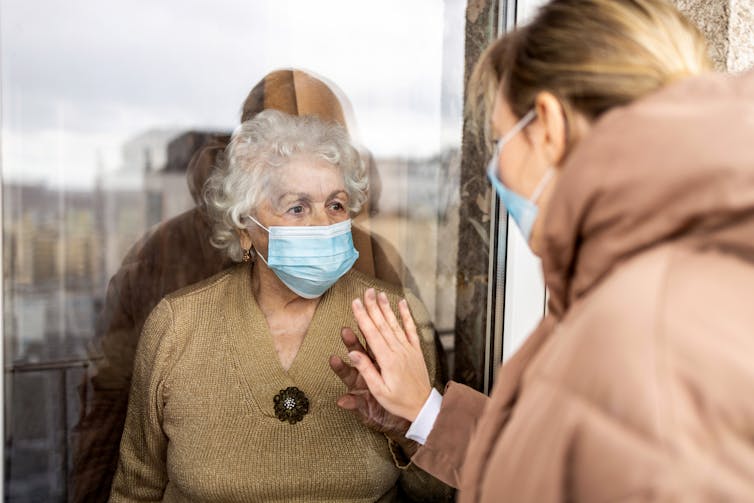
The COVID pandemic has had a huge impact on people living with dementia and their family carers around the world. Our study, published today, found people with dementia experienced worse symptoms after the pandemic began.
Carers reported their loved ones were more disoriented, restless and withdrawn. They also reported poorer mental health themselves as a result of the pandemic.
Dementia is an umbrella term that describes a range of progressive neurological disorders, such as Alzheimer’s disease and frontotemporal dementia.
The number of people living with dementia has more than doubled in the past 20 years worldwide. Dementia currently affects approximately 480,000 Australians, and one in ten people over the age of 65.
Nearly 1.6 million people in Australia care for someone living with dementia.
Given the progressive, neurodegenerative nature of dementia, deterioration of symptoms generally occurs gradually over time. However, we found an accelerated decline of symptoms over a short period of time (within a few months) during the pandemic, which may not be attributable to the typical course of dementia.
Why Is The Pandemic Particularly Challenging?
People with dementia can have difficulties understanding why public health measures are important. They may not understand why they can no longer hug or kiss their loved ones, or see them in person.
Symptoms of dementia such as perseverative behaviour (which might manifest as inflexibility to changes in routines) and disinhibition (which might involve approaching or touching strangers) can make it harder to follow public health guidance for social distancing, washing hands and wearing masks.
Mask wearing can also be uncomfortable and impact the person’s ability to recognise and communicate with other people.
Lockdowns and bans on visitors in aged care facilities have led to increased social isolation.
Loss of access to health, respite and community services have removed essential sources of support for both people with dementia and their family carers.
Worsening Symptoms Of Dementia
From April to November 2020, we conducted an online survey of 287 carers of people with dementia, from clinics in Australia, Spain, Germany and the Netherlands.
We asked carers about the impact of the pandemic on the person they were caring for, as well as their own mental health, social support and knowledge about the COVID pandemic.
We found 39% of people with dementia had worse depression since the COVID pandemic.
More than one-third of people with dementia had worse apathy (loss of motivation) and anxiety. They also had worse delusions, that is, unshakeable beliefs about things that are not true. For example becoming increasingly paranoid or suspicious of unfamiliar surroundings, such as people wearing personal protective equipment (PPE), and changes to their daily routines, such as not being able to see their families.

More than one-quarter had worse irritability and agitation compared to before the pandemic.
People with dementia who weren’t living with their carer (for example, those in aged care facilities) had a higher risk of worse outcomes. These symptoms may be exacerbated by the reduction in meaningful contact with their loved ones, and disconnection from their usual social activities and routines.
What About Carers?
More than half of carers reported they had worsened mental health since the pandemic began and 63% had a reduced social network.
Carers said they had difficulty managing day to day, due to the social isolation and the relentlessness of the condition.
Female carers reported worse mental health than male carers. While female carers are generally more likely to report greater stress, throughout the pandemic, women have also had to take on more household and family responsibilities and may be increasingly time-poor.
For those caring for someone living in an aged care home, not being able to visit their loved ones was distressing and added to their stress.
Interestingly, carers in Spain were less likely to report worsened mental health than carers in Australia and Germany. Intergenerational living and greater familial support networks for those living at home may have helped lessen the impact on carers’ mental health.

Balancing Protection And Social Connection
Compassionate care is vital during the pandemic, and helps to maintain cognitive and physical stimulation, and meaningful social connections.
To help support carers and people with dementia during the pandemic, we have developed a free, evidence-based toolkit, with tips on communicating health messages, managing symptoms and staying connected.
Understanding the lived experience is key to inform policy and health settings to balance risk and quality of life. Our findings suggest COVID restrictions, particularly on visits to aged care facilities, may lead to an accelerated decline for people with dementia, and poorer mental health outcomes for carers.
Encouragingly, national cabinet has endorsed a more “nuanced” approach to managing COVID-19 in aged care, rather than locking down entire facilities.
Going forward, we need to find other ways to protect people from virus transmission while also considering the psychological impact of isolation. ![]()
Grace Wei, PhD Candidate, Brain and Mind Centre & School of Psychology, University of Sydney and Fiona Kumfor, Associate professor, University of Sydney
This article is republished from The Conversation under a Creative Commons license. Read the original article.
Is this love … or an arrhythmia? Your heart really can skip a beat when you’re in love

We’ve seen it in our favourite romantic comedy – and for many of us, we’ve even felt it in real life. The door of the café swings open, in walks the person of your dreams. Momentarily you’re paralysed. Temporarily overwhelmed. And then you feel it, in your chest.
Is it love at first sight? Is your heart really beating faster than normal? Does it feel – even just for a second – like it’s skipped a beat?
It turns out the movie scenes, songs and poems are right to some extent. Feelings of love and attraction do affect the heart.
A Heartful Of Feelings … Also Blood Affected By Hormones
It’s actually quite normal for your heart to beat faster (or race) – and can happen when you are excited, nervous, angry or even if you’ve had too many coffees.
You’ve probably heard of the fight or flight response. Well, that also explains the feeling of your heart racing during a romantic moment.
Your brain sends a signal to your adrenal glands, two little hormone-producing organs that sit on top of your kidneys. This produces a small boost of the hormone adrenaline. It moves via your bloodstream directly to your heart, where its action is to temporarily make your heart beat faster.
The body appears to react this way, even though you’re not necessarily in danger. If you were running away from a bear, the increased heart rate would prepare your muscles to run. When love or attraction strikes, this might be your body’s way of preparing you to run into the arms of your perfect match.
Phew! So, It’s Not Life Threatening?
Probably not. Particularly if you don’t notice it happening frequently and are otherwise in good health.
In response to a surge of adrenaline, your heart racing is almost certainly due to sinus tachycardia. This is when your heart is still beating in a normal rhythm, but faster – like what happens during a good gym session or a run around the block.

There are other conditions which can cause someone to feel their heart is racing. Supraventricular tachycardia (SVT) is a condition which results from someone having an extra electrical circuit in the heart. We are all born with natural electrical circuits, but some people have an extra circuit. In certain situations, that circuit activates and causes palpitations. While the symptoms of SVT can be disconcerting, it is usually benign and can be easily treated with a small surgical procedure.
Another condition is atrial fibrillation (AF), which results in an irregular and sometimes very rapid heart rhythm. AF is the most common arrhythmia seen in clinical practice by cardiologists and its prevalence increases with age.
Approximately 5-10% of Australians will develop AF in their lifetimes. AF can vary in severity, from occasional episodes of electrical disturbance, to a more serious condition that can result in impairment of how the heart pumps, leading to poorer quality of life and a risk of stroke or heart failure. Some AF is effectively managed with medication, while other people may require cardioversion (delivering a small shock to the heart) or ablation (a procedure which deactivates cells in the heart that cause AF).

That Explains The Electricity. But Can It Actually Skip A Beat?
Yes. It’s absolutely possible for the heart to skip a beat. That can be triggered by the same things that make your heart race – stress, anxiety, dehydration and a range of other things. These premature beats are almost always benign, meaning they aren’t life-threatening or the sign of a heart attack in the making.
So, whether it’s love, or the excited thrill in anticipation of love – your heart really does behave differently when romance walks in the door. The best thing we can do for our hearts is maintain a healthy lifestyle. That means exercising regularly, quitting smoking and checking in with your doctor for a heart health screen to make sure it’s just love, and nothing more sinister.![]()

Hannah Brown, Science Strategy and Operations Manager, Victorian Heart Institute, Monash University and Hui-Chen Han, Research affiliate, Monash University
This article is republished from The Conversation under a Creative Commons license. Read the original article.
Haven’t yet been vaccinated for COVID? Novavax might change your mind

After significant delays in production and approval, Novavax – the first protein-based vaccine against COVID approved in Australia – is now available.
Unvaccinated Australians can receive Novavax for their first and second doses, at least three weeks apart, at pharmacies, GP clinics and vaccination hubs.
So what makes Novavax different from the other vaccines? And why are some people waiting for it to get vaccinated?
What Is Novavax?
Novavax (or Nuvaxovid) is a protein-based vaccine, meaning it contains a protein fragment of the COVID spike protein.
These fragments are taken by specialised immune cells which direct an immune response against the SARS-CoV-2 virus which causes COVID.
While these proteins are from the SARS-CoV-2 virus, there is no live virus in the vaccine, and it cannot cause COVID.
The company doesn’t even use SARS-CoV-2 virus to gather the protein, instead using moth cells which have been engineered to produce it.
Each of the two 0.5ml doses contain 5 micrograms of the spike protein and 50 micrograms of an adjuvant called Matrix-M. An adjuvant is a compound which stimulates the immune system. It ensures the immune system picks up the protein fragments.
Matrix-M is a compound derived from the soapbark plant (Quillaja saponaria). It forms part of the plant’s defence against insects and is used to improve the immune response with protein vaccines.
After injection, immune cells rapidly move to the injection site and clear both the adjuvant and viral proteins.
Who Can Get Novavax?
In Australia, Novavax is only approved for use in adults aged 18 and over, and only as a primary course of treatment – for doses one and two.
To date, there is no published data available on its efficacy and safety in children, or as a booster for adults.
This may change in coming months as paediatric and booster dose studies continue and additional data on this is provided to Australia’s regulator, the Therapeutic Goods Administraion (TGA).
How Effective Is It?
Novavax has been shown to be effective in clinical trials, particularly against the original, Alpha and Beta variants. In these studies, Novavax offered 90-92% protection against symptomatic disease, and higher protection against hospitalisation.
A study later showed a lower efficacy (60%) in South Africa against Beta, though it was small and complicated by a large HIV-positive population.
However, there is no specific evidence of Novavax’s efficacy against Omicron. The company reported in a press release its ongoing trial in 12 to 17 year olds has shown “robust immune responses”, though these reports are unverified by scientists.
Is It Safe? What Are The Side Effects?
Novavax has a similar safety profile to the other vaccines, with a number of common immediate side effects. These occurred in around 60% of those receiving a first dose and 80% with second dose.
The most common side effects were injection site pain and tenderness, headache, fatigue and muscle pain.

To date, no rare serious conditions are associated with Novavax. This includes blood clots associated with AstraZeneca. While there were three cases of heart inflammation in the trials, one was in the placebo group and the other two are yet to be clearly linked to the vaccine, due to the rarity of the adverse event.
However, further side effects may emerge as the vaccine rolls out across a larger population, as was the case with the other vaccines.
Why Are Some Waiting?
Some people have been waiting for Novavax to get vaccinated against COVID, because of fears about the mechanisms by which other vaccines work.
While Novavax directly places the COVID spike protein in reach of the immune system, the mRNA (Moderna and Pfizer) and vector (AstraZeneca and Johnson & Johnson) vaccines take advantage of our bodies’ own protein-making systems to produce it in the body.
This has been the centre of a mass misinformation campaign falsely claiming they cause permanent changes to our genetics, and therefore have long-term consequences. This is untrue but has still caused concern and vaccine hesitancy in some people.
Others who are unable to receive the mRNA or vector vaccines, such as those with polyethylene glycol (PEG) allergies, may be able to receive Novavax.
Further, some religious believers have concerns about how some COVID vaccines were developed using human embryonic cell lines, however these are cell lines grown in a lab from samples collected decades ago. No embryonic cells are included in the actual vaccines.
Novavax, in contrast, was developed using a moth cell line.
Whatever the reasons for choosing Novavax, its a welcome addition to Australia’s suite of vaccines and will likely boost our protection against COVID.![]()
Jack Feehan, Research Officer - Immunology and Translational Research, Victoria University and Vasso Apostolopoulos, Professor of Immunology and Associate Provost, Research Partnerships, Victoria University
This article is republished from The Conversation under a Creative Commons license. Read the original article.
Researchers Create Molecule That Can Pave Way For Mini-Transistors

Algorithm Could Shorten Quality Testing - Research In Many Industries By Months
Study Finds COVID-19 Vaccination Boosts Mental Health Along With Immunity
How Mars Lost Its Oceans
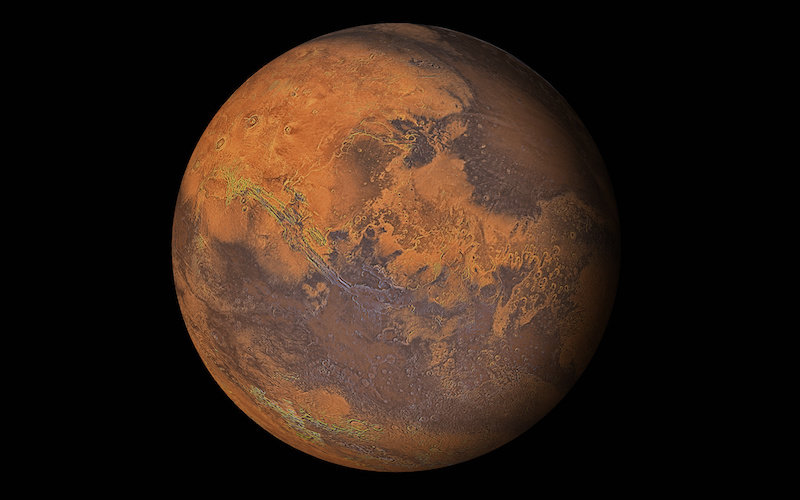 It has long been known that Mars once had oceans due in part to a protective magnetic field similar to Earth's. However, the magnetic field disappeared, and new research may finally be able to explain why. Researchers recreated conditions expected in the core of Mars billions of years ago and found that the behaviour of the molten metal thought to be present likely gave rise to a brief magnetic field that was destined to fade away.
It has long been known that Mars once had oceans due in part to a protective magnetic field similar to Earth's. However, the magnetic field disappeared, and new research may finally be able to explain why. Researchers recreated conditions expected in the core of Mars billions of years ago and found that the behaviour of the molten metal thought to be present likely gave rise to a brief magnetic field that was destined to fade away.Aboriginal Australians In Cities Have Dementia Rates As High As Those In Rural Areas
Study Highlights Worldwide Disparities In Treatment Rates For Major Depressive Disorder
Disclaimer: These articles are not intended to provide medical advice, diagnosis or treatment. Views expressed here do not necessarily reflect those of Pittwater Online News or its staff.